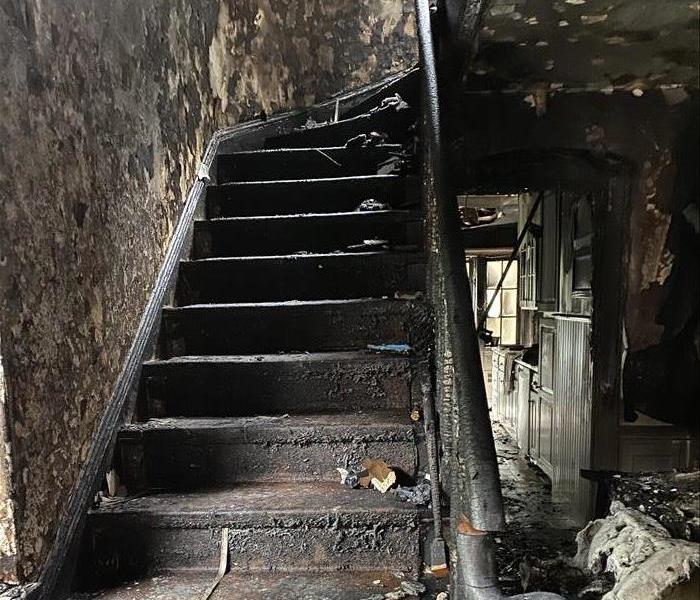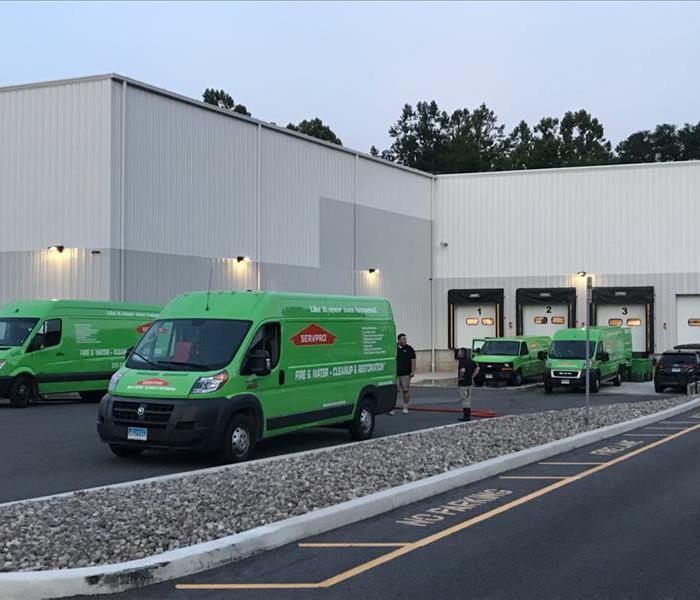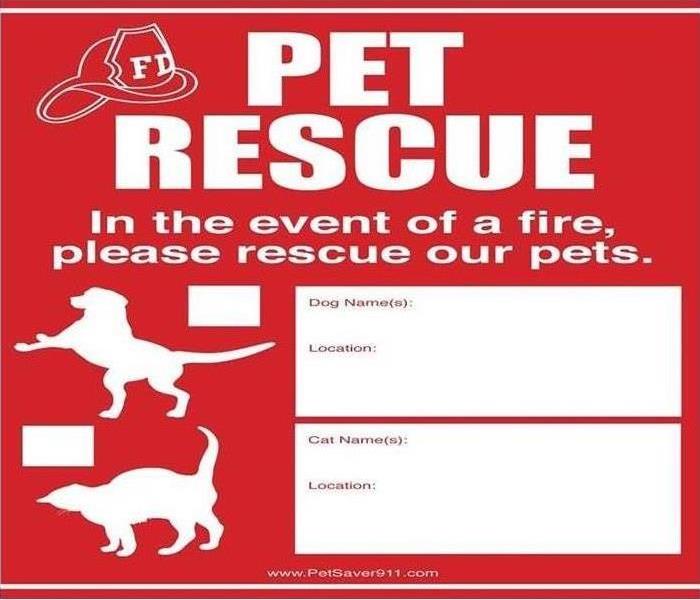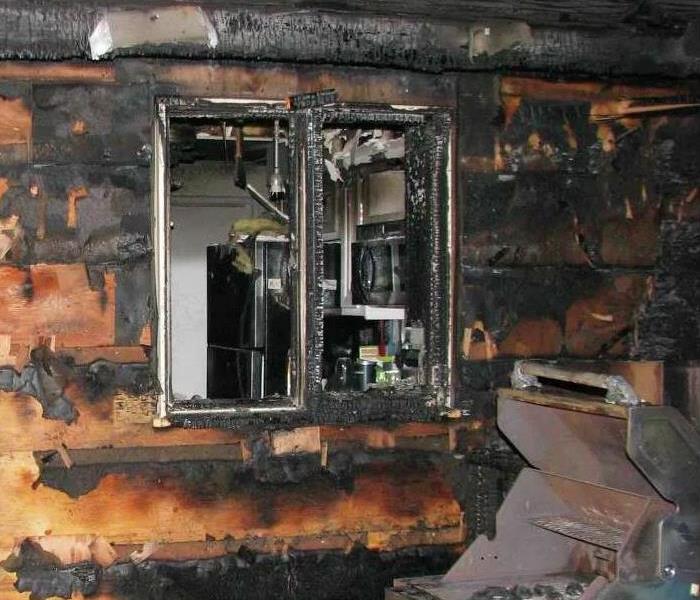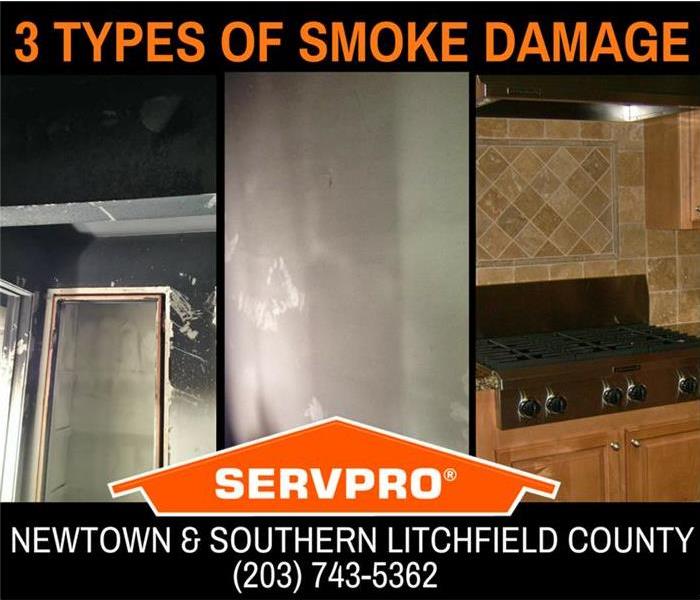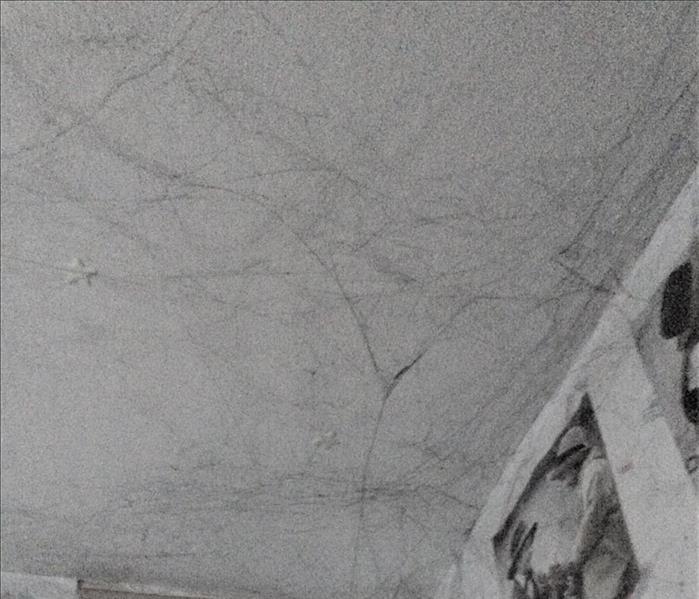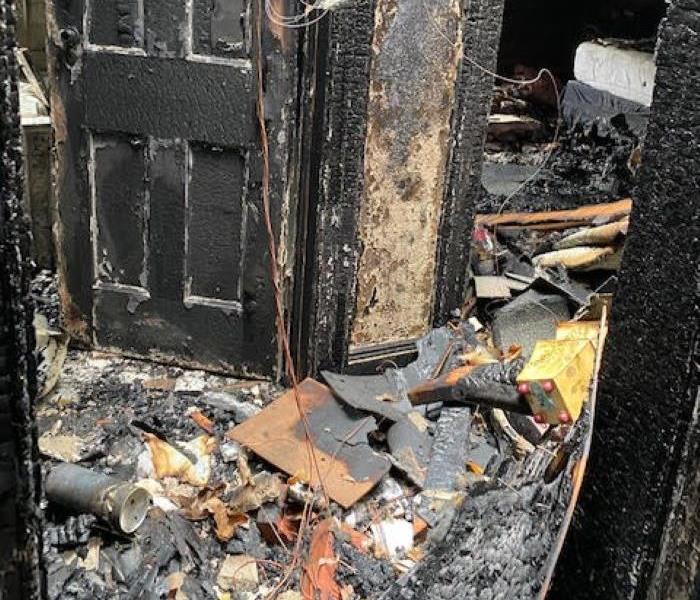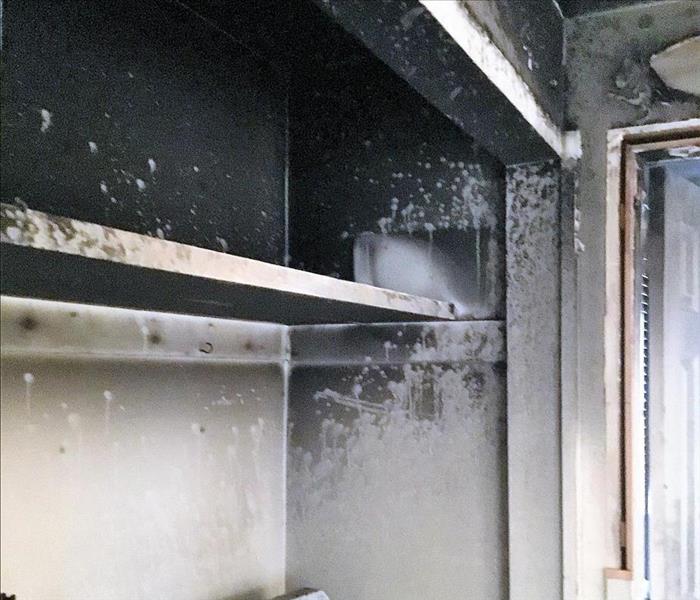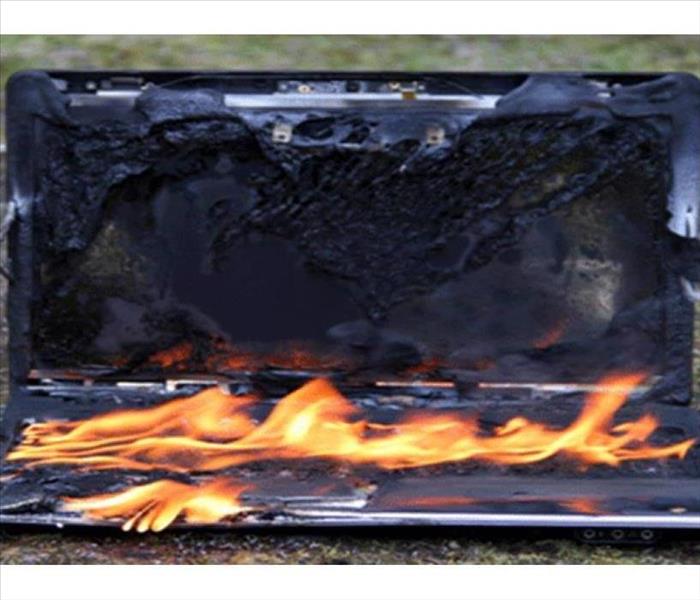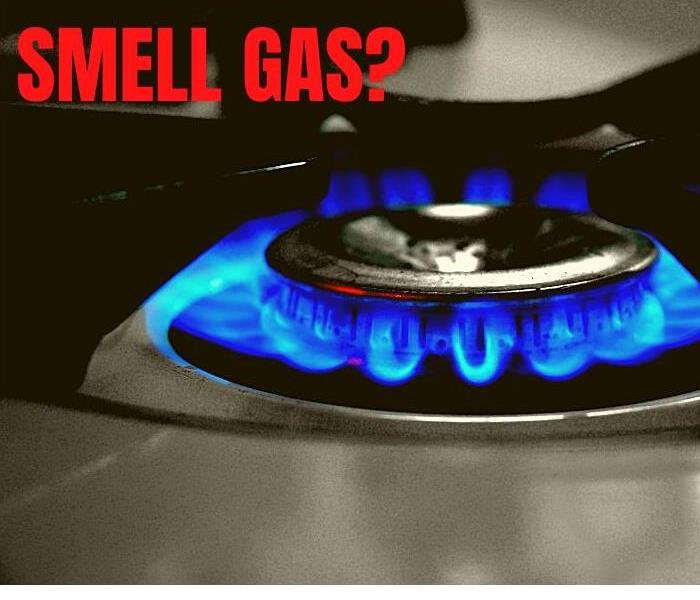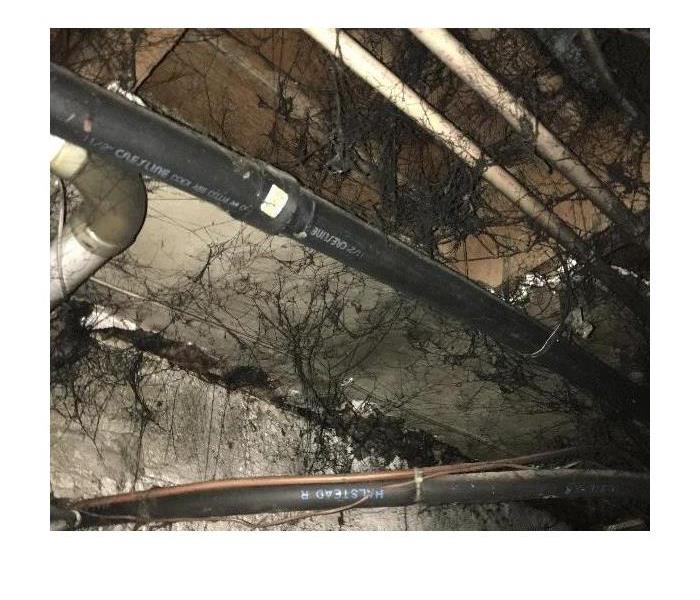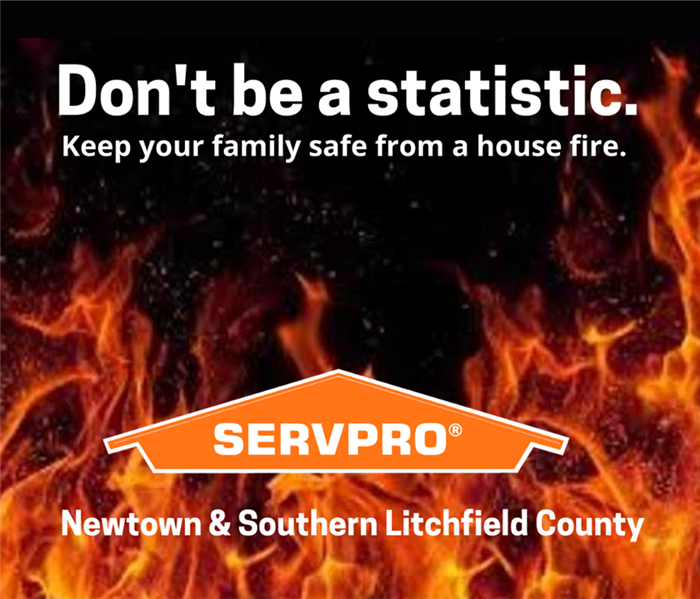Recent Fire Damage Posts
Restoring Hope: How SERVPRO's Fire Damage Restoration Services Renew Homes and Lives
5/20/2024 (Permalink)
In the aftermath of a fire, the devastation can feel insurmountable. Beyond the physical damage lies an emotional toll that can be overwhelming. However, amidst the chaos, there is hope. At SERVPRO®, we specialize in restoring not just buildings, but also lives, through our comprehensive fire damage restoration services. In this blog post, we'll explore how SERVPRO's expertise, dedication, and compassion help homeowners navigate the challenging journey of fire damage recovery.
The aftermath of a fire is a chaotic scene of destruction. Beyond the obvious structural damage, there's smoke residue, water damage from firefighting efforts, and the loss of personal belongings. It's a situation that can leave homeowners feeling lost and unsure of where to turn next. That's where SERVPRO steps in.
Assessment and Planning: The first step in our fire damage restoration process is a thorough assessment of the extent of the damage. Our team of experts meticulously inspects the property, identifying areas that require immediate attention and creating a customized restoration plan. We understand that every fire damage situation is unique, so we tailor our approach to meet the specific needs of each homeowner.
Smoke and Soot Removal: Smoke and soot residues can penetrate deep into building materials, leaving behind foul odors and unsightly stains. Our advanced techniques and equipment allow us to effectively remove smoke and soot particles from surfaces, ensuring a thorough cleanup. Whether it's scrubbing walls, cleaning upholstery, or deodorizing fabrics, SERVPRO leaves no trace of smoke damage behind.
Water Damage Mitigation: In many fire damage scenarios, water damage is also a significant concern due to the water used to extinguish the flames. SERVPRO's team is equipped to handle water extraction, drying, and dehumidification to prevent further damage and mold growth. Our goal is to restore the property to its pre-fire condition as quickly and efficiently as possible.
Structural Repairs and Reconstruction: Once the immediate threats have been addressed, we turn our attention to structural repairs and reconstruction. From repairing damaged walls and roofs to replacing flooring and cabinetry, SERVPRO's skilled technicians work tirelessly to rebuild what was lost. We understand the importance of restoring not just the physical structure, but also the sense of security and comfort that comes with it.
Support and Compassion: Throughout the fire damage restoration process, SERVPRO is more than just a restoration company – we're a support system for homeowners in their time of need. Our team approaches every project with empathy and compassion, understanding the emotional toll that a fire can take. We're here to guide homeowners through every step of the recovery process, offering reassurance and assistance along the way.
At SERVPRO, we believe that no fire damage is beyond repair. With our expertise, dedication, and compassion, we help homeowners navigate the challenging journey of fire damage recovery, restoring not just buildings, but also hope and peace of mind. If you've experienced a fire, don't despair – let SERVPRO be your partner in rebuilding and renewal.
Smoke and Soot Cleaning After the Fire
8/23/2023 (Permalink)
Some of the toughest jobs we respond to are house fires. It can be devastating, both physically and emotionally, for the family who has experienced such a loss. Not only is there damage from the fire itself, the smoke and soot can render many possessions unsalvageable. On top of that, water damage from fire fighting efforts adds another layer of damage. Our team knows how important it is to save whatever we can of your belongings. We have technicians trained and experienced in the art of content cleaning, which can take different forms depending on the item.
Dry-Cleaning: In order to remove smoke and soot from porous items such as clothing, furniture and drapery, we use the dry cleaning method. The soot has to be removed from the textiles before they are washed with water.
Ultrasonic: Non-porous items can go through a more vigorous cleaning than materials that soak up water. The ultrasonic treatment incorporates ultrasound and a cleaning solvent to rid your belongings of soot.
High-Pressure Water: In some circumstances, such as for larger items, our technicians opt to use high-pressure water treatment on non-porous household items.
Odor Removal: Smoke isn't the only thing that can cling to your possessions. The smell can linger after all visible signs of fire damage has disappeared. Our team may use thermal fogging or ozone treatments to make your home smelling good again.
With decades in the business, our team has helped hundreds of families back into their homes after house fires. If you are faced with such a loss, please know that we are available to help.
After the Fire: Board Ups and Pack Outs
8/14/2023 (Permalink)
When your business or home has had a fire, the restoration process involves more than the structural restoration of your home. In addition to cleaning the smoke from the air in your home and the soot off of the surfaces, SERVPRO of Newtown and Southern Litchfield County offers the following services:
Board-ups In many cases in which there has been a fire, it is necessary to secure the openings of your home, such as the windows, doors and the roof. The SERVPRO of Newtown and Southern Litchfield County team uses sturdy, durable materials designed to protect homes from both the outside elements such as rain and snow as well as intrusion by outsiders. This is often one of the first actions we will take when we arrive at the job - even if it’s in the middle of the night.
Move-Outs After a fire, it may be necessary to move some or all of your personal belongings and furniture out of your home. This may be to protect your contents, to make the restoration and rebuild of your home easier and also in order to clean your things off site. Our franchise offers a pack out service and also has a dedicated storage facility in which we can store your items. Items such as carpeting, electronics, artwork and furniture might be restored off site by our technicians.
Inventory When your home or business has experienced a fire, it is important to take an inventory of the contents inside prior to anything being discarded or packed up. At SERVPRO, we use a system called the Contents Claim Inventory Service (CCIS), which allows us to generate comprehensive room-by-room inventories. As we go through the items , we will categorize the contents as salvageable, non-salvageable and questionable. This allows for easier contents settlement with your insurance company. Home fires are devastating.
Even if the structural damage is minimal, the process of cleaning the smoke out of the air and your belongings can be extensive. SERVPRO Of Newtown and Southern Litchfield County is here to help you step by step through the process.
Fire Preparedness with your Pet in Mind
9/1/2022 (Permalink)
Not only are house fires devastating because of the damage they inflict to your home, but many people also lose their pets in such fires. There are safety precautions that can be taken to help protect your pets in the case of fire.
If you leave your pet home unattended (whether for an extended period of time or daily while you are at work), consider installing a monitored smoke detector. If the alarm goes off while you are away, emergency services will be alerted.
Also consider placing a pet rescue sticker on the door or window. Such stickers inform emergency responders information about the pets inside of your house, such as how many and what kind are inside.
During your household fire drills, include your pets. Know where your pet may hide in the event that they are scared of the fire itself, the smoke alarms and fire trucks. Practice your drill with your smoke detectors ringing so that your pet will associate the noise with the evacuation routine.
Have a plan in place. Designate a family member who is responsible for each pet as well as a backup. If your pet cannot be safely located because of smoke or flames, leave windows and doors open as an escape route. Always have identification tags on your pet, as they sometimes run away out of fear. Tags will ensure their return if they are found.
Nobody expects to experience a house fire, but having a safety plan in place will help keep your fur baby safe in the event that you do. If you have a house fire in the New Fairfield, CT area, give SERVPRO of Newtown and Southern Litchfield County a call at (203) 743-5362.
House Fires Caused by Outdoor Grills
6/21/2022 (Permalink)
It is officially summertime and that means grilling season has hit Fairfield County! Before you grill, however, take caution. Nearly 9,000 Americans get injured due to the grill each year, the majority of which are caused by user error. Follow these tips to keep your gathering fun and incident free.
- Keep your grill AT LEAST 10 feet away from your house. This includes areas with overhangs such as porches. A 'certain somebody' in our office learned the hard way that vinyl siding near a barbecue melts quite easily. Save your siding and move that grill far away!
- Clean your grill each time. Open up that fancy grill cleaning set that you received at last year's 'white elephant' and have some fun! Scrub that grill clean each time that it is used and remove the grease that can be a major cause of flare ups.
- Check for gas leaks. Here's a cool trick on how to check. Make a solution of half liquid dish soap and half water and rubbing it on the hoses and connections. Then, turn the gas on (with the grill lid open.) If the soap forms large bubbles, that's a sign that the hoses have tiny holes or that the connections are not tight enough.
- Keep the area clear. Keep your patio furniture, pillows, party lights and hanging baskets away from your grill, as they are highly combustible.
- Keep a spray bottle of water handy. That way, if you have a minor flare-up you can spray it with the water to instantly calm it. And, as a bonus, you can still eat your burger even after you've sprayed the flames out!
- Keep a fire extinguisher within a couple steps of your grill. Quickly extinguishing the fire will save your home and safety. Here's the catch, though - make sure that you know how to use it!
- Don't turn on the gas unless your grill lid is open! Keeping the lid closed causes gas to build up inside your grill, and when you do light it and open it, a fireball can explode in your face. And a fireball in the face almost always ruins the barbecue.
- Don't leave a grill unattended. Grilling is serious business. Fires double in size every minute. You cannot just put the steaks on the grill and walk away to watch the game. Man your post at all times and keep an eye on that grill!
- Don't overload your grill with fatty meats. If too much fat drips on the flames at once, it can cause a large flare-up that could light nearby things on fire.
- Don't use a grill indoors. I'm sure this goes without saying. Even a small little propane grill inside can cause a big fire as well as produce enough carbon monoxide to threaten the health of your family and kids. Keep grills outdoors where they can vent in the fresh air.
Keep it safe! Although it may make a good story someday, having a visit from the Fire Department is never a fun way to end you holiday!
"What is the cause of the fire?"
1/14/2022 (Permalink)
When we receive a call from a homeowner who has had a fire, one of the first questions we ask is "What is the cause of the fire?"
This information will help us determine what kind of smoke damage you have and establish the proper restoration plan. Not all smoke is equal and each different type requires a different method of cleaning. A quick breakdown of the types of smoke residue is:
- Wet Smoke Residue -Wet smoke residue occurs from smoldering fires with low heat. During these fires, synthetic materials such as plastics and rubbers, carpeting, furniture and electronics will have slowly smoldered. They tend to have a pungent odor and leave a sticky residue. During cleaning, wet smoke residue can smear, making cleanup more difficult.
- Dry Smoke Residue – Dry smoke residue occurs during fast burning fires that burn at a high temperature. Natural materials such as paper, leather, natural rubber and wood are present in dry smoke fires. Dry smoke residue is generally dry, powdery, gray in color and does not smear much. Homes that have experienced these fires are easier for our crew to restore.
- Protein Residue – Protein fires are most commonly caused when food burns in a kitchen. Protein residue is essentially invisible and a homeowner may be under a false impression that the damage is minor. However, there is actually soot covering the surfaces. If not properly removed, protein smoke will discolor paints, varnishes, and other finishes on your walls and cabinetry. One major indicator that there is an invisible residue after a kitchen fire is a very strong, obnoxious odor.
The SERVPRO of Newtown & Southern Litchfield County team treats each fire damage job individually and will determine which course of action to take after arriving at your home. Call us at (203) 743-5362 for a quick response, an evaluation of your home's fire damage and a professional restoration plan.
Smoke and Soot Cleaning After a Home Fire
12/4/2021 (Permalink)
Some of the toughest jobs we respond to are house fires. It can be devastating, both physically and emotionally, for the family who has experienced such a loss. Not only is there damage from the fire itself, the smoke and soot can render many possessions unsalvageable. On top of that, water damage from fire fighting efforts adds another layer of damage. Our team knows how important it is to save whatever we can of your belongings. We have technicians trained and experienced in the art of content cleaning, which can take different forms depending on the item.
Dry-Cleaning: In order to remove smoke and soot from porous items such as clothing, furniture and drapery, we use the dry cleaning method. The soot has to be removed from the textiles before they are washed with water.
Ultrasonic: Non-porous items can go through a more vigorous cleaning than materials that soak up water. The ultrasonic treatment incorporates ultrasound and a cleaning solvent to rid your belongings of soot.
High-Pressure Water: In some circumstances, such as for larger items, our technicians opt to use high-pressure water treatment on non-porous household items.
Odor Removal: Smoke isn't the only thing that can cling to your possessions. The smell can linger after all visible signs of fire damage has disappeared. Our team may use thermal fogging or ozone treatments to make your home smelling good again.
With decades in the business, our team has helped hundreds of families back into their homes after house fires. If you are faced with such a loss, please know that we are available to help.
Black Spiderwebs in Your Home?
11/15/2021 (Permalink)
With the arrival of cold weather in the New Milford area, the calls coming to our office take a different tone.
Winter brings calls from homeowners who have had burst pipes and chimney fires as well as furnace puffbacks. A puffback is a messy furnace malfunction that occurs when an oil burner backfires, sending soot throughout the interior of a home. Puff backs happen when your oil burning furnace doesn't ignite when it should. This causes oil vapors to build up which results in an explosion when the igniter finally triggers. The result of this is soot and other debris is forced from the furnace's exhaust system. The soot then enters the homes heating system and gets blown throughout the home.
If you see signs of a puffback in your home, call your oil company immediately for an inspection of your furnace. If a homeowner hasn't experienced a puff back before, they might mistake the soot on their surfaces for dust and attempt to wipe it away. However, soot cannot but easily wiped away- it requires specialized cleaning by your local SERVPRO franchise.
At SERVPRO of Newtown and Southern Litchfield County, we have the tools, training and experience to get your home back to properly remove soot in your home. Call us at (203) 743-5362 for immediate service.
Use a Turkey Fryer? Avoid a Fire With These Tips.
10/25/2021 (Permalink)
To be honest, I’ve never fried my Thanksgiving turkey. My family has always gone the traditional route and roasted our bird in the oven. I am tempted, however, to give it a try this year because so many people swear by how amazing and flavorful a fried turkey is.
Working in the fire damage restoration business, however, I’ve seen the damage a turkey fryer can do to a home. Turkey fryer fires are more common than you’d imagine and are devastating because everything surrounding the fire is engulfed in the flames.
So, why does frying a turkey carry the risk of fire?
I know. It’s cold in Connecticut by the last Thursday of November and you may not want to be standing outside while the rest of the meal is cooking in the kitchen. But turkeys should ALWAYS be fried outside. Just because you’ve been doing it in your garage for 10 years and never had a problem doesn’t mean it can't happen to you. Because the hot oil will spray everywhere when cooking, a 10’ radius around the fryer is necessary. It quickly starts a fire when making contact with combustible materials, such as wood or fabric. If the oil touches bare skin, it can also cause severe burns.
One common mistake people make is using a frozen turkey. This is because when a frozen turkey is submerged into a pot of oil, the oil doesn’t mix with the frozen water on the turkey. Instead, heavy pockets of water will sink to the bottom of the fryer while the oil surrounding them quickly heats it beyond its boiling point. The water then evaporates, expands, and splatters the oil everywhere, including the burner. Upon hitting the burner, the beads of oil ignite into flames that spread out in all directions. If you have marinated your turkey in a brine, make sure it is fully dry prior to putting in the oil.
Measure your oil carefully, making certain that it is 4-6” below rim after the turkey is palced in it. . When you lower the turkey in, be sure to be wearing oven mitts, long sleeves, pants, and close-toed shoes. Hot oil will stick to bare skin, causing severe burns that can result in an emergency trip to the hospital.
Even a seasoned turkey fryer can have an accident that causes disaster. The turkey can slip from your hands when lowering it into the fryer or your rope-and-pulley system could break, spilling the oil everywhere and igniting a fire. The point is that something can always go wrong when frying a turkey; therefore, you should always be prepared and have a fire extinguisher by your side at all times.
We hate to see someone's holiday ruined by a house fire due to a cooking accident. But if you do have a Thanksgiving disaster, we have teams on call 24/7 - even on the holidays and are Here to Help.
How to Avoid a Kitchen Fire in Connecticut
9/3/2021 (Permalink)
Let's talk about kitchen fires. It's actually amazing, when you think about it, that there aren't MORE fires in the kitchen.
Every household is cooking on a daily basis and we are all bound at some time or another to forget about a pot left on the stove top ("I'll check back during the commercial") or neglect to clean up that grease spill in the oven from the last time you cooked (any busy moms out there?). Proportionally, for the number of us cooking each day, the number of fires that are caused by cooking is not too substantial.
However, according to the National Fire Protection Agency, there are 471 cooking fires PER DAY in the United States. This means that as Connecticut's leading fire restoration company, we typically receive a few calls a month from homes in which there has been a kitchen fire.
Since you can't stop cooking, the best that you can do to avoid a visit from us is:
1. Never leave food unattended. Ok, but realistically, you have to go check the baby or you're just going to sit down for a few minutes. So, set a timer whenever you leave the kitchen. You don't think that you will forget that you are cooking but neither do those other 471 people every day. Get one of those cute little egg timers that you will love using if it helps to remember!
2. Practice Microwave Safety. Of course your family knows not to put metal in the microwave. You've told them a million times, right? Well, let's face it, sometimes they might not listen to you. And, sometimes, the metal is hidden, as in a twist tie or food wrapper. The best advice we can give is to never leave a microwave unattended. And leave a note on the microwave reminding kids (and those young at heart) to double check for metal. If a fire does start in the microwave, unplug it and leave the door shut.
3. Have a fire extinguisher in your kitchen. Or, at least a big box of baking soda - they cost about $2 and can safely extinguish a stove top fire.
471 every day is a big number - try to avoid being part of that statistic. However, fires happen and if you have one, we are here to help.
After the Fire: Board Ups and Pack-Outs
6/21/2021 (Permalink)
When your business or home has had a fire, the restoration process involves more than the structural restoration of your home.
In addition to cleaning the smoke from the air in your home and the soot off of the surfaces, SERVPRO of Newtown and Southern Litchfield County offers the following services:
Board-ups
In many cases in which there has been a fire, it is necessary to secure the openings of your home, such as the windows, doors and the roof. The SERVPRO of Newtown and Southern Litchfield County team uses sturdy, durable materials designed to protect homes from both the outside elements such as rain and snow as well as intrusion by outsiders. This is often one of the first actions we will take when we arrive at the job - even if it’s in the middle of the night.
Move-Outs
After a fire, it may be necessary to move some or all of your personal belongings and furniture out of your home. This may be to protect your contents, to make the restoration and rebuild of your home easier and also in order to clean your things off site. Our franchise offers a pack out service and also has a dedicated storage facility in which we can store your items. Items such as carpeting, electronics, artwork and furniture might be restored off site by our technicians.
Inventory
When your home or business has experienced a fire, it is important to take an inventory of the contents inside prior to anything being discarded or packed up. At SERVPRO, we use a system called the Contents Claim Inventory Service (CCIS), which allows us to generate comprehensive room-by-room inventories. As we go through the items , we will categorize the contents as salvageable, non-salvageable and questionable. This allows for easier contents settlement with your insurance company.
Home fires are devastating. Even if the structural damage is minimal, the process of cleaning the smoke out of the air and your belongings can be extensive.
SERVPRO Of Newtown and Southern Litchfield County is here to help you step by step through the process.
Fire Hazards: Batteries, Microwaves, Laptops and Clutter
1/19/2021 (Permalink)
Most people are aware of the common causes of house fires – including fireplaces, old electrical wires and candle. At SERVPRO of Newtown and Southern Litchfield County, we have restored homes in which the fire was caused by other, less common but still equally as destructive, sources.
- Battery Fires: You’d be surprised at how widespread a fire from household batteries can be. When the terminals touch each other, or a metal source such as a key, a fire can start. Batteries should be stored in a battery storage case, if one is available. If you do not have one, store them standing up, rather than loose in a container or drawer. Shorts can be prevented by placing electrical tape over the ends when they are being stored as well as when disposing. 9 volt batteries are particularly risky due to the proximity of their terminals. Never throw batteries into your garbage can or even in a bag together as that could start a fire.
- Microwave Fires: Microwaves can catch fire for a number of reasons- from unnoticed metals on dinnerware or take out containers to overcooking food such as burnt popcorn. Microwaves can also malfunction and catch fire. If something in your microwave has caught fire, unplug it if it is safe to do. Do not open the microwave door, as this will fuel the fire with oxygen. With no air, the fire should suffocate itself.
- Dryer Lint: Make sure that everybody in your family knows to clean the dryer lint out of your dryer with every load. Because the lint trap only catches 25% of the lint, the exhaust and duct work should also be cleaned periodically.
- Light bulbs: The main cause of lightbulb fires is when a light bulb with too high of wattage for a given outlet is used. Be sure to check the label on your lamp and when in doubt, keep it under 60 watts. Caution must also be taken when using CFLs (compact fluorescents). The spiral shaped CFL’s should not be used in an enclosed fixture. If your CFLs are burning out early and you notice they are brown at the base when you remove them, the bulbs are overheating and could result in fire. The newer LED lights are cooler and less prone to causes a fire and also have a much nicer glow to them.
- Laptops: We’ve all felt the heat of a laptop on our lap after its been used for a while. You may have even seen some photos of a laptop that burned somebody’s bedding.
Laptops can get pretty hot during normal operation. Never leave your laptop on a bed or couch, or any place where its cooling vents are blocked. This could result in fire. Store laptops securely on a desk or laptop stand. - Clutter: Stacks of newspapers or magazines can ignite quickly if left too close to a heat source. If you must keep old newspapers or magazines, be certain to store them in a cool, dry place in short stacks. The same goes for any clutter – whether that be a pile of sweaters stacked in your closet next to a light bulb or stuffed animals that touch a nightlight.
- Old appliances: The wiring on older appliances often becomes worn and begin to disintegrate. Check them regularly to ensure good working condition and the safety of cords and connections. Even if your unit is working properly, consider replacing it if the electrical wiring is not up to code.
These tips take little time and effort to follow and can save you from a house fire.
Smell Gas in Your Home? Here's What to Do.
12/7/2020 (Permalink)
SUSPECT A GAS LEAK? USE YOUR SENSES
See
A white cloud, mist or fog, bubbles in still water, blowing dust, or dead or dying plants.
Smell
A distinct rotten egg-like odor.
Hear
Unusual hissing, roaring or whistling.
IF YOU SUSPECT A LEAK, DO ...
Leave
Immediately move to a safe location. Don't start your car, as a spark could ignite.
Call 911
Call 911. Don't assume someone else made the call. Report your location, including cross streets, and whether there's digging nearby.
IF YOU SUSPECT A LEAK, DON'T ...
- Smoke.
- Light a match.
- Open doors or windows.
- Use your landline or cell phone.
- Switch on/off appliances.
- Use a flashlight.
- Start a car.
- Attempt to make repairs.
In many cases, a gas leak will not result in a house fire. However, if one does occur in your home, please call us for immediate fire damage restoration service.
Picking the Right Christmas Tree Can Help Keep Your Home Safe
11/30/2020 (Permalink)
 While the picture might be classic, placing your tree this close to a fireplace is a fire hazard.
While the picture might be classic, placing your tree this close to a fireplace is a fire hazard.
For many families in Litchfield County, the start of the Christmas season is marked by picking out a live Christmas tree from one of the area’s wonderful tree farms. For some, the annual ritual of the family venturing out into the cold together to find that perfect tree for their home, cutting it themselves and tying it to the roof of the car cannot be replicated with an artificial tree.
We appreciate a live tree ourselves however have also seen in over twenty years in the fire and damage business the devastation caused by a tree that has caught fire. When showcasing a live tree in your home, the combination of tree dryness, electrical malfunction with lights and poorly located heating sources can make for a deadly combination. If your holiday is not complete without a live tree, follow these safety precautions this month.
1. Choose your tree carefully: Fresh trees are less likely to catch fire, so look for a tree with vibrant green needles that are hard to pluck and don’t break easily from its branches. The best trees that retain moisture the longest are Fraser fir, Noble fir and Douglas fir. Eastern red cedar and Atlantic white cedar rapidly lose moisture and should be used only for a week or two.
2. Location, location, location: Always place your tree away from heat sources like fireplaces, radiators, candles, heat vents or lights, and keep the tree base filled with water to avoid a dry out.
3. Check your lights: Check old lights for any fraying of the wires. Do not overload light strands or electrical outlets. Also keep in mind that miniature and LED lights produce less heat than larger ones and will reduce the drying effect on trees.
4. Keep it watered: Choose a tree stand that holds at least a gallon of water and be sure to keep it full at all times.
5. Unplug your lights every night and when you leave the home. This will reduce the drying effect of lights and reduce the risk of the tree igniting unnoticed.
6. Take down the tree before it dries completely. A tree that is totally dry has needles turned a greenish gray and all needles and twigs break with a crack or crunch when crushed. In some tree species, you will see a needle drop but always do the crush test to be certain.
With the Winter Chill Comes Furnace Puffbacks
11/2/2020 (Permalink)
Many people have never heard of a furnace puff back until they experience one themselves.
A puff back is an explosion inside the burner chamber of the furnace or boiler. Puff backs can occur due to an oil burner malfunction in which the burner doesn't ignite immediately and oil fumes are allowed to build up before ignition, causing an explosion when the furnace turns on. Puff backs can also be caused by a partially clogged or cracked nozzles, improper nozzle angle, cracked electrodes, poor adjustment of the air-fuel mixture, a defective spark transformer, shorted ignition cables or dirty or low-grade fuel. Regular maintenance can help Litchfield County homeowners reduce the risk of a furnace puffback.
The aftermath of a puffback is the soot and streaks that the explosion blew throughout your home. Often every surface – including carpeting, furniture, walls and drapery - is covered with this black, sticky substance that includes a mixture of oil that is very difficult to remove from any surface. Cleaning up after a puffback is not a do it yourself job- it requires professional cleaning to remove the soot that is spread throughout your home. Do not attempt to clean the soot itself – household cleaners are not effective against soot and may make the problem worse. For example, attempts to wash soot off of a flat-painted wall or ceiling usually leave greasy smears.
At SERVPRO, we use proprietary tools and cleaners that absorb the soot without spreading it. Luckily, puffback's are usually covered under your homeowner's insurance.
If you experience a furnace puffback, call your SERVPRO of Newtown and Southern Litchfield County office at (203) 743-5362. Our smoke and fire damage specialists have the equipment and training to quickly return your home to a safe, clean, and comfortable environment for you and your family. We're faster to any disaster and are dedicated to responding immediately so that you can recover quickly, with less disruption to your life.
Don't Be a Statistic
9/6/2020 (Permalink)
Statistics kept by the National Fire Protection Agency(NFPA) reveal that there were 501,500 structure fires reported in the U.S. in 2015. These fires resulted in 2,685 deaths, 13,000 injuries, and $10.3 billion in property damage; $7 billion in property losses were caused by home fires. Based on these statistics, a fire was reported every 63 seconds.
Electrical distribution and lighting equipment fires account for 9% of all fires in U.S. households. Knowing which appliances in your household are most likely to cause a fire can help you reduce the chance that it will happen to you.
Dishwashers. If you have ever opened your dishwasher up immediately after the dry cycle is done, you know how hot it gets in there. There are heating elements inside of your dishwasher that dry your dishes. They get a lot of wear and tear as they repeatedly heat up, get wet and cool down. If the element is faulty or has damaged wiring, a fire can easily start.
Many of us don't think to have our dishwashers inspected but it could be a good idea, especially if your house or your dishwasher is more than ten years old.
Dryers. Most of the people I know are aware that the lint trap can be a fire hazard if not cleaned out. The lint can also make its way into the vent and block it so be certain to clean it out fully, each time, including under the lint tray.
If clothing that is contaminated with combustibles like gasoline are put in the dryer, they can start a fire. The same goes for items that contain chemicals that are flammable such as rubber backed rugs or sneakers.
If the exhaust vent for your dryer is improperly installed, blocked or crushed, the inability for heat to escape can cause a fire as well.
Toasters.The toaster is a small appliance that can cause big damage. The cord can become crimped or caught under the element, which can cause it to melt. A failure to clean out the crumb tray is also a culprit in many toaster fires.
With the electricity running to each appliance every day, it's no surprise that fires can occur. In addition to the reasons discussed above, there is also the reality that sometimes a manufacturing fault causes an appliance fire. When it comes down to it, the best thing that you can do to protect your home from fire damage is to only run appliances when you are home. In particular, never run a dryer or dishwasher when you are out and unplug appliances such as the toaster, microwave and coffee maker when not in use.
Nobody ever plans on being the statistic. While not all house fires can be prevented, these simple steps can reduce the chance of it happening to you.
Burning Down the House? Ways to Grill Safely in Fairfield County
6/24/2020 (Permalink)
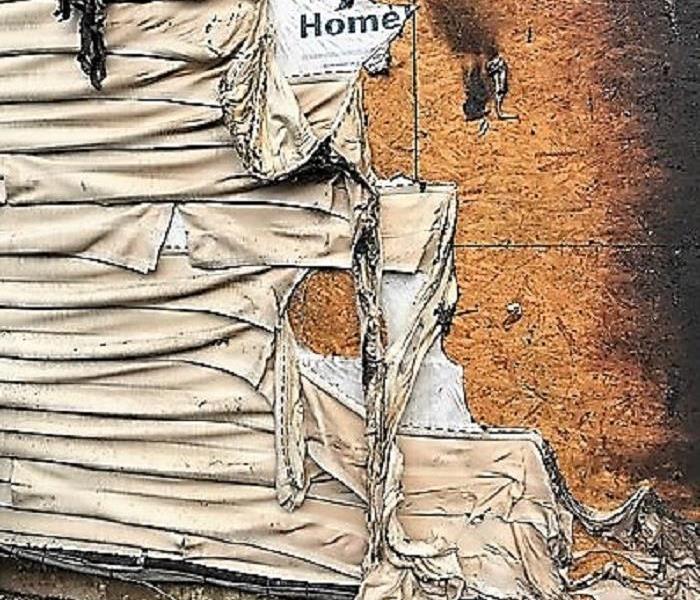 Even when several feet away, your grill can melt the siding of your house in a matter of minutes.
Even when several feet away, your grill can melt the siding of your house in a matter of minutes.
Friends, it is officially summertime and that means grilling season has hit Fairfield County! Before you grill, however, take caution. Nearly 9,000 Americans get injured due to the grill each year, the majority of which are caused by user error. Follow these tips to keep your gathering fun and incident free.
- Keep your grill AT LEAST 10 feet away from your house. This includes areas with overhangs such as porches. A 'certain somebody' in our office learned the hard way that vinyl siding near a barbecue melts quite easily. Save your siding and move that grill far away!
- Clean your grill each time. Open up that fancy grill cleaning set that you received at last year's 'white elephant' and have some fun! Scrub that grill clean each time that it is used and remove the grease that can be a major cause of flare ups.
- Check for gas leaks. Here's a cool trick on how to check.Make a solution of half liquid dish soap and half water and rubbing it on the hoses and connections. Then, turn the gas on (with the grill lid open.) If the soap forms large bubbles, that's a sign that the hoses have tiny holes or that the connections are not tight enough.
- Keep the area clear. Keep your patio furniture, pillows, party lights and hanging baskets away from your grill, as they are highly combustible.
- Keep a spray bottle of water handy.That way, if you have a minor flare-up you can spray it with the water to instantly calm it. And, as a bonus, you can still eat your burger even after you've sprayed the flames out!
- Keep a fire extinguisher within a couple steps of your grill. Quickly extinguishing the fire will save your home and safety. Here's the catch, though - make sure that you know how to use it!
- Don't turn on the gas unless your grill lid is open! Keeping the lid closed causes gas to build up inside your grill, and when you do light it and open it, a fireball can explode in your face. And a fireball in the face almost always ruins the barbecue.
- Don't leave a grill unattended. Grilling is serious business. Fires double in size every minute. You cannot just put the steaks on the grill and walk away to watch the game. Man your post at all times and keep an eye on that grill!
- Don't overload your grill with fatty meats. If too much fat drips on the flames at once, it can cause a large flare-up that could light nearby things on fire.
- Don't use a grill indoors.I'm sure this goes without saying. Even a small little propane grill inside can cause a big fire as well as produce enough carbon monoxide to threaten the health of your family and kids. Keep grills outdoors where they can vent in the fresh air.
Keep it safe! Although it may make a good story someday, having a visit from the Fire Department is never a fun way to end you holiday!
471 Kitchen Fires a Day. Cooking Safety in Connecticut.
1/27/2020 (Permalink)
Let's talk about kitchen fires. It's actually amazing, when you think about it, that there aren't MORE fires in the kitchen.
Every household is cooking on a daily basis and we are all bound at some time or another to forget about a pot left on the stove top ("I'll check back during the commercial") or neglect to clean up that grease spill in the oven from the last time you cooked (any busy moms out there?). Proportionally, for the number of us cooking each day, the number of fires that are caused by cooking is not too substantial.
However, according to the National Fire Protection Agency, there are 471 cooking fires PER DAY in the United States. This means that as Connecticut's leading fire restoration company, we typically receive a few calls a month from homes in which there has been a kitchen fire.
Since you can't stop cooking, the best that you can do to avoid a visit from us is:
1. Never leave food unattended. Ok, but realistically, you have to go check the baby or you're just going to sit down for a few minutes. So, set a timer whenever you leave the kitchen. You don't think that you will forget that you are cooking but neither do those other 471 people every day. Get one of those cute little egg timers that you will love using if it helps to remember!
2. Practice Microwave Safety. Of course your family knows not to put metal in the microwave. You've told them a million times, right? Well, let's face it, sometimes they might not listen to you. And, sometimes, the metal is hidden, as in a twist tie or food wrapper. The best advice we can give is to never leave a microwave unattended. And leave a note on the microwave reminding kids (and those young at heart) to double check for metal. If a fire does start in the microwave, unplug it and leave the door shut.
3. Have a fire extinguisher in your kitchen. Or, at least a big box of baking soda - they cost about $2 and can safely extinguish a stove top fire.
471 every day is a big number - try to avoid being part of that statistic. However, fires happen and if you have one, we are here to help.
Furnaces Puffbacks: When Your Home is Covered With a Layer of Soot
12/11/2019 (Permalink)
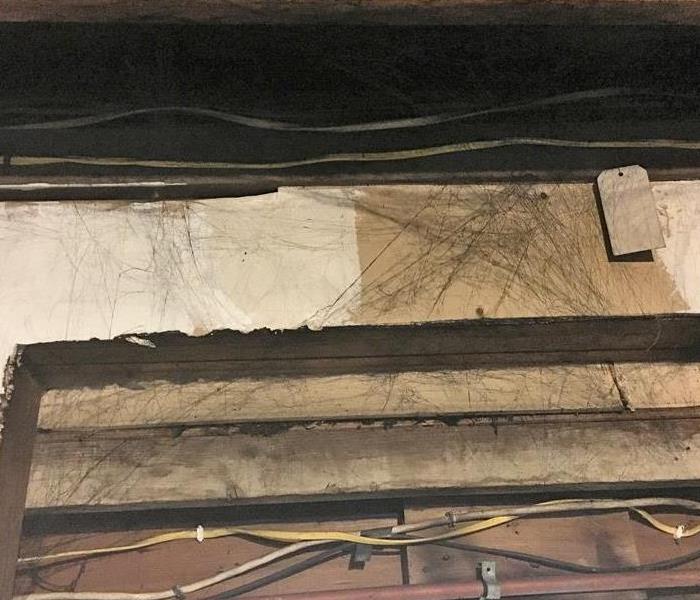 A sure sign of a puffback is black "spiderwebs" that are caused by the explosion.
A sure sign of a puffback is black "spiderwebs" that are caused by the explosion.
With the arrival of cold weather in the New Milford area, the calls coming to our office take a different tone.
Winter brings calls from homeowners who have had burst pipes and chimney fires as well as furnace puffbacks. A puffback is a messy furnace malfunction that occurs when an oil burner backfires, sending soot throughout the interior of a home. Puff backs happen when your oil burning furnace doesn't ignite when it should. This causes oil vapors to build up which results in an explosion when the igniter finally triggers. The result of this is soot and other debris is forced from the furnace's exhaust system. The soot then enters the homes heating system and gets blown throughout the home.
If you see signs of a puffback in your home, call your oil company immediately for an inspection of your furnace. If a homeowner hasn't experienced a puff back before, they might mistake the soot on their surfaces for dust and attempt to wipe it away. However, soot cannot but easily wiped away- it requires specialized cleaning by your local SERVPRO franchise.
At SERVPRO of Newtown and Southern Litchfield County, we have the tools, training and experience to get your home back to properly remove soot in your home. Call us at (203) 743-5362 for immediate service.
Don't Let a Kitchen Fire Ruin Your Holiday
11/27/2019 (Permalink)
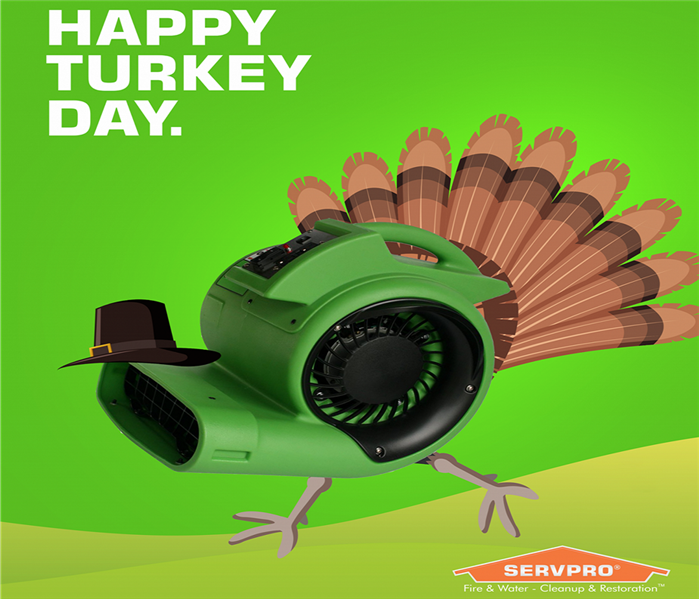 Happy Thanksgiving to all of our friends, family and customers!
Happy Thanksgiving to all of our friends, family and customers!
Thanksgiving is a day filled with family, parades, football and, of course, food!
The kitchen is the heart of home, especially during the holidays when most of us in Litchfield County are preparing a meal with many more recipes, in larger quantities and with more cooks in the kitchen than usual!
Unfortunately, Thanksgiving Day also has the highest number of home fires annually. In 2013, Thanksgiving Day had 1,550 reported kitchen fires, which is 230% above the average number of fires per day. Keep these kitchen safety reminders in mind as you prepare your Thanksgiving feast!
"Be on time"
With so many things on your "to do" list, guests coming and going and multiple items cooking, be sure to set timers so that you don't remember to take something out of the oven too late! (nobody likes their stuffing THAT dry!)
“Stand by Your Pan”
Have a designated cook in the kitchen at all times so that food is not left unattended. This is the most common source of kitchen fires. It only takes a moment for a kitchen fire to start and with a vigilant cook in the kitchen, catching it immediately is the key to avoiding the fire spreading.
"If you fry, don't make it too high!"
The popularity of deep frying the turkey has soared (We at SERVPRO of Newtown and Southern Litchfield County haven't gone this route because we are traditionalists but we hear it's quite delicious!). An overfilled cooking pot will cause cooking oil to spill when the turkey is put in, and a partially frozen turkey will cause cooking oil to splatter when put in the pot. Even a small amount of cooking oil spilling on a hot burner can cause a large fire. Play it safe and fry your bird outside.
"For grease fires, water makes it go higher!"
Never attempt to extinguish a grease fire with water or a wet towel. Water will cause the flames to flare up and spread quickly. Turn off the stove and cover the fire with a lid if it is safe to do so, thereby removing the oxygen from reaching the fire. Use a fire extinguisher, which should be stored in a convenient kitchen location (not hidden under the kitchen sink!) If you do not have a fire extinguisher, baking soda is also effective at putting out grease fires however you do need to use quite a bit of it.
We wish all of you a Happy Thanksgiving!
House Fire Safety Precautions with Your Fur-Baby in Mind
11/19/2019 (Permalink)
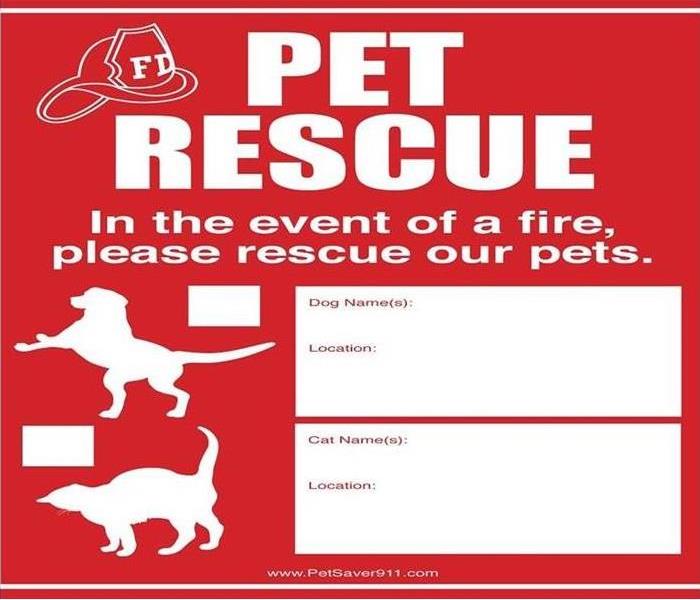 Placing a Pet Rescue sticker on your window lets rescue personnel know that there is a loved one inside!
Placing a Pet Rescue sticker on your window lets rescue personnel know that there is a loved one inside!
Not only are house fires devastating because of the damage they inflict to your home, but many people also lose their pets in such fires. There are safety precautions that can be taken to help protect your pets in the case of fire.
If you leave your pet home unattended (whether for an extended period of time or daily while you are at work), consider installing a monitored smoke detector. If the alarm goes off while you are away, emergency services will be alerted.
Also consider placing a pet rescue sticker on the door or window. Such stickers inform emergency responders information about the pets inside of your house, such as how many and what kind are inside.
During your household fire drills, include your pets. Know where your pet may hide in the event that they are scared of the fire itself, the smoke alarms and fire trucks. Practice your drill with your smoke detectors ringing so that your pet will associate the noise with the evacuation routine.
Have a plan in place. Designate a family member who is responsible for each pet as well as a backup. If your pet cannot be safely located because of smoke or flames, leave windows and doors open as an escape route. Always have identification tags on your pet, as they sometimes run away out of fear. Tags will ensure their return if they are found.
Nobody expects to experience a house fire, but having a safety plan in place will help keep your fur baby safe in the event that you do. If you have a house fire in the New Fairfield, CT area, give SERVPRO of Newtown and Southern Litchfield County a call at (203) 743-5362.
#firedamage #housefire #petsafety #petrescue #SERVPRO #emergencypreparedness #pets
Fire Damage Restoration: Board-Ups, Packouts, Inventory and Contents Cleaning
9/24/2019 (Permalink)
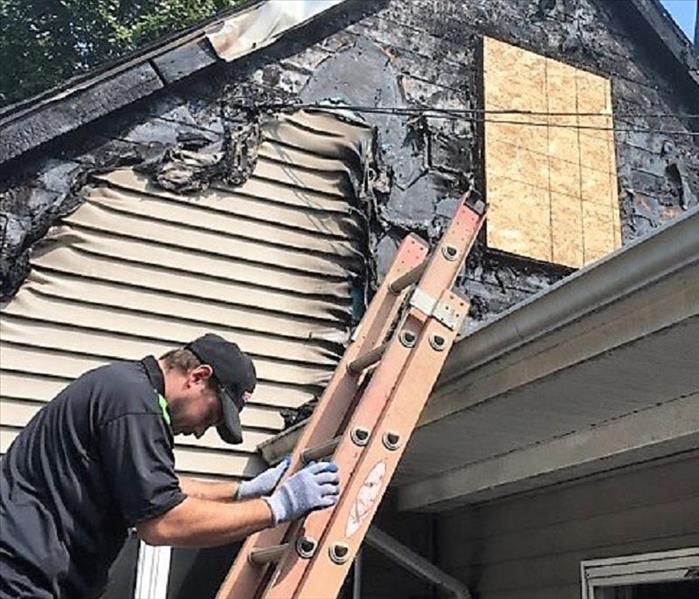 When your home has had a fire, it's important that we board up the windows and doors. This protects your home from any further damage.
When your home has had a fire, it's important that we board up the windows and doors. This protects your home from any further damage.
When your business or home has had a fire, the restoration process involves more than the structural restoration of your home.
In addition to cleaning the smoke from the air in your home and the soot off of the surfaces, SERVPRO of Newtown and Southern Litchfield County offers the following services:
Board-ups
In many cases in which there has been a fire, it is necessary to secure the openings of your home, such as the windows, doors and the roof. The SERVPRO of Newtown and Southern Litchfield County team uses sturdy, durable materials designed to protect homes from both the outside elements such as rain and snow as well as intrusion by outsiders. This is often one of the first actions we will take when we arrive at the job - even if it’s in the middle of the night.
Move-Outs
After a fire, it may be necessary to move some or all of your personal belongings and furniture out of your home. This may be to protect your contents, to make the restoration and rebuild of your home easier and also in order to clean your things off site. Our franchise offers a pack out service and also has a dedicated storage facility in which we can store your items. Items such as carpeting, electronics, artwork and furniture might be restored off site by our technicians.
Inventory
When your home or business has experienced a fire, it is important to take an inventory of the contents inside prior to anything being discarded or packed up. At SERVPRO, we use a system called the Contents Claim Inventory Service (CCIS), which allows us to generate comprehensive room-by-room inventories. As we go through the items , we will categorize the contents as salvageable, non-salvageable and questionable. This allows for easier contents settlement with your insurance company.
Home fires are devastating. Even if the structural damage is minimal, the process of cleaning the smoke out of the air and your belongings can be extensive.
SERVPRO Of Newtown and Southern Litchfield County is here to help you step by step through the process.
Don't Be a Statistic: Ways to Avoid an Appliance Fire in Your Home
8/15/2019 (Permalink)
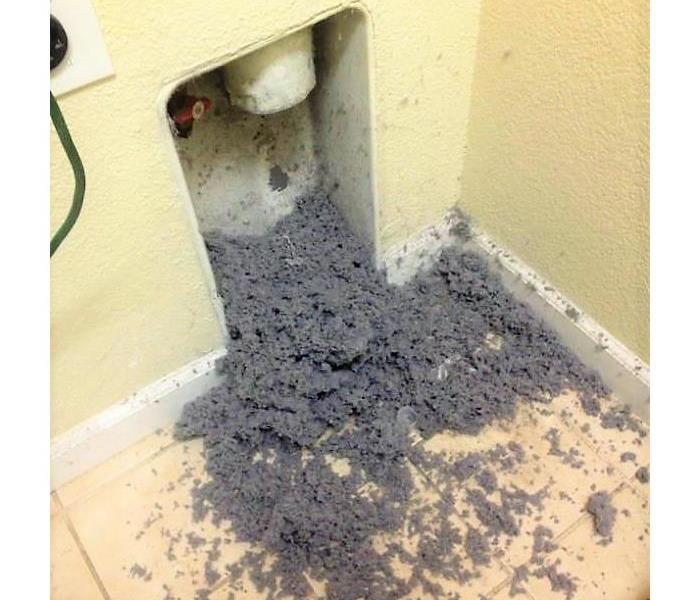 Dryer lint is one of the leading causes of appliance fires.
Dryer lint is one of the leading causes of appliance fires.
Statistics kept by the National Fire Protection Agency(NFPA) reveal that there were 501,500 structure fires reported in the U.S. in 2015. These fires resulted in 2,685 deaths, 13,000 injuries, and $10.3 billion in property damage; $7 billion in property losses were caused by home fires. Based on these statistics, a fire was reported every 63 seconds.
Electrical distribution and lighting equipment fires account for 9% of all fires in U.S. households. Knowing which appliances in your household are most likely to cause a fire can help you reduce the chance that it will happen to you.
Dishwashers. If you have ever opened your dishwasher up immediately after the dry cycle is done, you know how hot it gets in there. There are heating elements inside of your dishwasher that dry your dishes. They get a lot of wear and tear as they repeatedly heat up, get wet and cool down. If the element is faulty or has damaged wiring, a fire can easily start.
Many of us don't think to have our dishwashers inspected but it could be a good idea, especially if your house or your dishwasher is more than ten years old.
Dryers. Most of the people I know are aware that the lint trap can be a fire hazard if not cleaned out. The lint can also make its way into the vent and block it so be certain to clean it out fully, each time, including under the lint tray.
If clothing that is contaminated with combustibles like gasoline are put in the dryer, they can start a fire. The same goes for items that contain chemicals that are flammable such as rubber backed rugs or sneakers.
If the exhaust vent for your dryer is improperly installed, blocked or crushed, the inability for heat to escape can cause a fire as well.
Toasters.The toaster is a small appliance that can cause big damage. The cord can become crimped or caught under the element, which can cause it to melt. A failure to clean out the crumb tray is also a culprit in many toaster fires.
With the electricity running to each appliance every day, it's no surprise that fires can occur. In addition to the reasons discussed above, there is also the reality that sometimes a manufacturing fault causes an appliance fire. When it comes down to it, the best thing that you can do to protect your home from fire damage is to only run appliances when you are home. In particular, never run a dryer or dishwasher when you are out and unplug appliances such as the toaster, microwave and coffee maker when not in use.
Nobody ever plans on being the statistic. While not all house fires can be prevented, these simple steps can reduce the chance of it happening to you.
What is a Furnace Puffback, Anyway?
1/29/2019 (Permalink)
 When fumes build up in a furnace due to a malfunction, a puffback can occur, which can leave a fine layer of soot throughout your Newtown home.
When fumes build up in a furnace due to a malfunction, a puffback can occur, which can leave a fine layer of soot throughout your Newtown home.
Many people have not heard of the term puffback until they have experienced one, as was the case with a recent job at a Bethel home that we restored.
The homeowner came home from shopping and noticed what appeared to be black grease on her countertops. It didn't take long for her to realize that there was a major problem in the home. There was a fine layer of black soot on her floors, cabinets and walls throughout several rooms of the house. A trip to the basement confirmed that the problem originated at the furnace. The homeowner called in her service professional, who informed her she had experienced a furnace puffback.
What is a puffback and why does it happen?
A puffback occurs when the oil burner malfunctions. This can be because the burner doesn’t ignite immediately and a buildup of fumes causes an explosion similar to that of a car backfiring. Puff backs can also happen when debris builds up and causes an explosion when the boiler turns on. In either case, the explosion sends soot and debris through the furnace or boilers exhaust system and into your home. In our experience, the soot tends to be more widespread in forced hot air systems as the heating ducts spread the soot with same efficiency that they spread air throughout the home.
A puffback leaves a fine layer of oil based soot on all of the surfaces of a home. This includes hard surfaces such as floors, walls and furniture as well as soft furnishings such as curtains, bedding, clothing and carpeting. In fact, because it is literally blasted throughout your house, the soot manages to find its way into every nook and cranny.
What are the signs that you've had a puffback?
You may first notice a black sticky film on your countertops and then realize that it is widespread throughout your home. Some homeowners will see what appears to be black spiderwebs in the corners of your rooms - this is a common way the soot collects and settles.
How are puffbacks cleaned up?
Attempts to remove the soot will prove futile and possibly make the damage worse. Because of its oil based nature, the residue left after a puffback requires professional restoration. The SERVPRO of Newtown and Southern Litchfield County team is experienced, trained and equipped to properly clean your home and it’s contents of oil and soot. The good news is that puffbacks are typically covered under your homeowners insurance policy. When you experience a puffback, call your oil burner specialist, your insurance agent and our office at (203) 743-5362 for immediate service.
Space Heaters Cause Majority of Home Heating Fires in Litchfield County
1/3/2019 (Permalink)
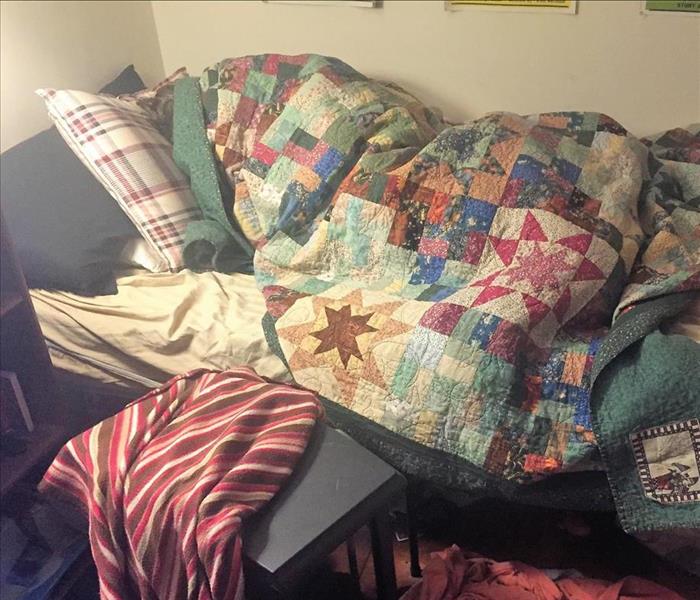 How many space heater safety rules are being broken in this photo? Make sure that everyone in your house follows fire safety recommendations!
How many space heater safety rules are being broken in this photo? Make sure that everyone in your house follows fire safety recommendations!
Like many Connecticut homeowners, we primarily heat our house with a wood stove in the winter.
It’s an economical way to heat the home and for the most part, does the job. However, there’s a room between the barn and the rest of our house that is cold no matter what we do. We've used window and door insulation and used fans to direct the heat from the stove towards it with little improvement. Our solution is to use an electric space heater in the room. It’s a new infrared heater and we have no reason to suspect that it will malfunction however I work in the restoration industry and am regularly reminded of the fire risks associated with using a space heater in the home.
Statistics show that between the years 2011 and 2015, space heaters accounted for 43% of U.S. home heating fires and 85% of home heating fire deaths. Space heaters are the second-leading cause of U.S. home fires and the third-leading cause of home fire deaths. Precautions must be taken when using a space heater in your home.
We recommend that you follow these safety precautions and make sure that others in your home are also vigilant about them.
- Make sure your space heater has the label showing that it is listed by a recognized testing laboratory and read the instructions thoroughly.
- When you pull the electric heater out of storage at the beginning of the season, check it over for any frayed, worn, chewed or damaged cords as well as any other damage that may have occurred. Space heaters can be purchased for under $50 - there is no reason to take a risk and use an old worn out heater.
- Be sure to place your space heater in a safe location. Heaters must be kept at least three feet away from anything that can burn, including upholstered furniture, bedding, drapes and rugs. This does mean that you may need to rearrange a room to safely use a space heater. I personally roll the rug in front of my space heater up whenever it is turned on to avoid a fire risk.
- Never leave a space heater unattended. This is the number one factor that causes deaths do to a space heater. If left on at night or when you leave the home, you will not be alerted to the fire before it has become widespread. Install smoke alarms on every floor of your home and outside all sleeping areas and test them once a month.
- Be extra vigilant when using a space heater in the bedroom. It can be difficult to avoid bedding and laundry from coming too close to the heater. Many bedrooms have wall to wall carpeting, which can also be a fire hazard. From personal experience, I can’t stress too much the importance of making sure your teenager doesn’t leave dirty laundry on top of an electric heater and allow his blankets to drape over it while it is turned on at the base of his bed all night.
- Plug space heaters directly into a wall outlet. Do not use an extension cord or power strip, which could overheat and result in a fire. Do not plug any other electrical devices into the same outlet as the heater.
- Place space heaters on level, flat surfaces. Never place heaters on cabinets, tables, furniture, or carpet, which can overheat and start a fire.
If your space heater does start a fire in your home, do not attempt to extinguish it using water. We recommend that you turn off the power at the breaker box, use a Class C fire extinguisher to put out the fire and call 9-1-1 if necessary.
Even small home fires that may not leave a lot of structural damage can cause significant smoke and soot damage and require professional restoration. SERVPRO of Newtown and Southern Litchfield County has the training and tools to clean the fire damage in your home in your Brookfield area home.
Give our office a call at (203) 743-5362. if you have damage from an electrical fire.
Furnace Puffbacks Leave a Sticky Mess in Brookfield Homes
12/20/2018 (Permalink)
Many people have never heard of a furnace puff back until they experience one themselves.
A puff back is an explosion inside the burner chamber of the furnace or boiler. Puff backs can occur due to an oil burner malfunction in which the burner doesn't ignite immediately and oil fumes are allowed to build up before ignition, causing an explosion when the furnace turns on. Puff backs can also be caused by a partially clogged or cracked nozzles, improper nozzle angle, cracked electrodes, poor adjustment of the air-fuel mixture, a defective spark transformer, shorted ignition cables or dirty or low-grade fuel. Regular maintenance can help Litchfield County homeowners reduce the risk of a furnace puffback.
The aftermath of a puffback is the soot and streaks that the explosion blew throughout your home. Often every surface – including carpeting, furniture, walls and drapery - is covered with this black, sticky substance that includes a mixture of oil that is very difficult to remove from any surface. Cleaning up after a puffback is not a do it yourself job- it requires professional cleaning to remove the soot that is spread throughout your home. Do not attempt to clean the soot itself – household cleaners are not effective against soot and may make the problem worse. For example, attempts to wash soot off of a flat-painted wall or ceiling usually leave greasy smears.
At SERVPRO, we use proprietary tools and cleaners that absorb the soot without spreading it. Luckily, puffback's are usually covered under your homeowner's insurance.
If you experience a furnace puffback, call your SERVPRO of Newtown and Southern Litchfield County office at (203) 743-5362. Our smoke and fire damage specialists have the equipment and training to quickly return your home to a safe, clean, and comfortable environment for you and your family. We're faster to any disaster and are dedicated to responding immediately so that you can recover quickly, with less disruption to your life.
Choosing and Caring for a Christmas Tree to Avoid a Home Fire
12/12/2018 (Permalink)
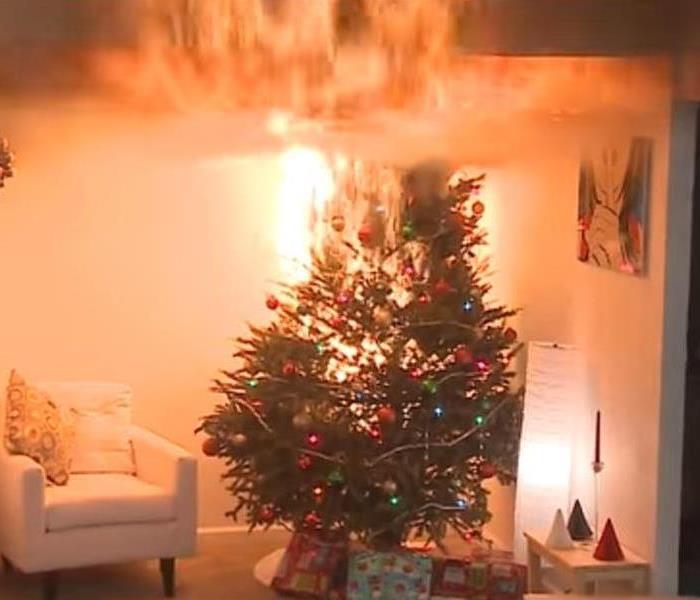 A failure to water your live Christmas tree can result in a house fire.
A failure to water your live Christmas tree can result in a house fire.
For many families in Litchfield County, the start of the Christmas season is marked by picking out a live Christmas tree from one of the area’s wonderful tree farms. For some, the annual ritual of the family venturing out into the cold together to find that perfect tree for their home, cutting it themselves and tying it to the roof of the car cannot be replicated with an artificial tree.
We appreciate a live tree ourselves however have also seen in over twenty years in the fire and damage business the devastation caused by a tree that has caught fire. When showcasing a live tree in your home, the combination of tree dryness, electrical malfunction with lights and poorly located heating sources can make for a deadly combination. If your holiday is not complete without a live tree, follow these safety precautions this month.
1. Choose your tree carefully: Fresh trees are less likely to catch fire, so look for a tree with vibrant green needles that are hard to pluck and don’t break easily from its branches. The best trees that retain moisture the longest are Fraser fir, Noble fir and Douglas fir. Eastern red cedar and Atlantic white cedar rapidly lose moisture and should be used only for a week or two.
2. Location, location, location: Always place your tree away from heat sources like fireplaces, radiators, candles, heat vents or lights, and keep the tree base filled with water to avoid a dry out.
3. Check your lights: Check old lights for any fraying of the wires. Do not overload light strands or electrical outlets. Also keep in mind that miniature and LED lights produce less heat than larger ones and will reduce the drying effect on trees.
4. Keep it watered: Choose a tree stand that holds at least a gallon of water and be sure to keep it full at all times.
5. Unplug your lights every night and when you leave the home. This will reduce the drying effect of lights and reduce the risk of the tree igniting unnoticed.
6. Take down the tree before it dries completely. A tree that is totally dry has needles turned a greenish gray and all needles and twigs break with a crack or crunch when crushed. In some tree species, you will see a needle drop but always do the crush test to be certain.
SERVPRO of Newtown and Southern Litchfield County Restores Homes After Puffback Disasters
10/9/2018 (Permalink)
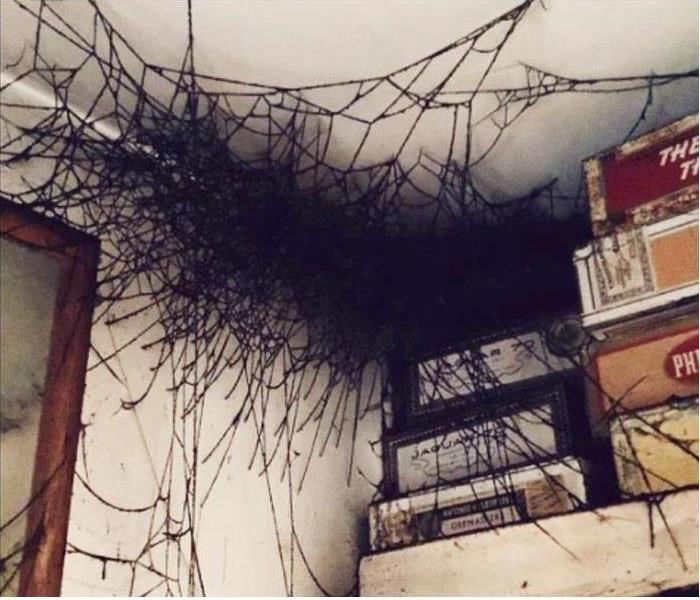 SERVPRO of Newtown and Southern Litchfield County cleans soot webs that are left throughout homes after an oil burner puffback.
SERVPRO of Newtown and Southern Litchfield County cleans soot webs that are left throughout homes after an oil burner puffback.
With the arrival of cold weather in the New Milford area, the calls coming to our office take a different tone. Winter brings calls from homeowners who have had burst pipes and chimney fires as well as furnace puffbacks.
A puffback is a messy furnace malfunction that occurs when an oil burner backfires, sending soot throughout the interior of a home. Puff backs happen when your oil burning furnace doesn't ignite when it should. This causes oil vapors to build up which results in an explosion when the igniter finally triggers. The result of this is soot and other debris is forced from the furnace's exhaust system. The soot then enters the homes heating system and gets blown throughout the home.
If you see signs of a puffback in your Newtown home, call your oil company immediately for an inspection of your furnace. If a homeowner hasn't experienced a puff back before, they might mistake the soot on their surfaces for dust and attempt to wipe it away. However, soot cannot but easily wiped away- it requires specialized cleaning by your local SERVPRO franchise.
At SERVPRO of Newtown and Southern Litchfield County, we have the tools, training and experience to get your Fairfield County home back to properly remove soot in your home. Call us at (203) 743-5362 for immediate service.
Microwaves, Batteries, Laptops and Old Appliances Cause House Fires
8/29/2018 (Permalink)
 Leaving a laptop on your bed can cause it to overheat and cause a house fire.
Leaving a laptop on your bed can cause it to overheat and cause a house fire.
Most people are aware of the common causes of house fires – including fireplaces, old electrical wires and candle. At SERVPRO of Newtown and Southern Litchfield County, we have restored homes in which the fire was caused by other, less common but still equally as destructive, sources.
- Battery Fires: You’d be surprised at how widespread a fire from household batteries can be. When the terminals touch each other, or a metal source such as a key, a fire can start. Batteries should be stored in a battery storage case, if one is available. If you do not have one, store them standing up, rather than loose in a container or drawer. Shorts can be prevented by placing electrical tape over the ends when they are being stored as well as when disposing. 9 volt batteries are particularly risky due to the proximity of their terminals. Never throw batteries into your garbage can or even in a bag together as that could start a fire, as this homeowner discovered when his home burned down due to 9 volt batteries.
- Microwave Fires: Microwaves can catch fire for a number of reasons- from unnoticed metals on dinnerware or take out containers to overcooking food such as burnt popcorn. Microwaves can also malfunction and catch fire. If something in your microwave has caught fire, unplug it if it is safe to do. Do not open the microwave door, as this will fuel the fire with oxygen. With no air, the fire should suffocate itself.
- Dryer Lint: Make sure that everybody in your family knows to clean the dryer lint out of your dryer with every load. Because the lint trap only catches 25% of the lint, the exhaust and duct work should also be cleaned periodically.
- Light bulbs: The main cause of lightbulb fires is when a light bulb with too high of wattage for a given outlet is used. Be sure to check the label on your lamp and when in doubt, keep it under 60 watts. Caution must also be taken when using CFLs (compact fluorescents). The spiral shaped CFL’s should not be used in an enclosed fixture. If your CFLs are burning out early and you notice they are brown at the base when you remove them, the bulbs are overheating and could result in fire. The newer LED lights are cooler and less prone to causes a fire and also have a much nicer glow to them.
- Laptops: We’ve all felt the heat of a laptop on our lap after its been used for a while. You may have even seen some photos of a laptop that burned somebody’s bedding.
Laptops can get pretty hot during normal operation. Never leave your laptop on a bed or couch, or any place where its cooling vents are blocked. This could result in fire. Store laptops securely on a desk or laptop stand. - Clutter: Stacks of newspapers or magazines can ignite quickly if left too close to a heat source. If you must keep old newspapers or magazines, be certain to store them in a cool, dry place in short stacks. The same goes for any clutter – whether that be a pile of sweaters stacked in your closet next to a light bulb or stuffed animals that touch a nightlight.
- Old appliances: The wiring on older appliances often becomes worn and begin to disintegrate. Check them regularly to ensure good working condition and the safety of cords and connections. Even if your unit is working properly, consider replacing it if the electrical wiring is not up to code.
These tips take little time and effort to follow and can save you from a house fire.
Tips to Keep Your Campfire Safe This Summer
6/20/2018 (Permalink)
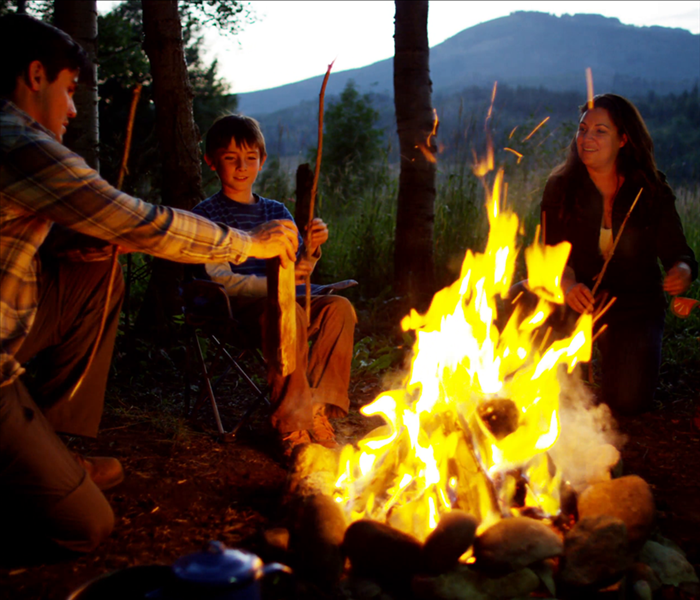 Camping one of our favorite ways to spend with family and friends over the summertime.
Camping one of our favorite ways to spend with family and friends over the summertime.
One thing that we look forward to every summer is having a campfire in our backyard. There's something about the smell and sound of a fire that brings us close to nature. Add in some marshmallows and everybody is happy! Unfortunately, campfire accidents are common, resulting in thousands of ER visits a year.
Follow our safety tips to reduce your risk of injury.
Step 1: Check out the surroundings
Carefully choose your location avoiding any low hanging branches or near brush or bushes. These can easily go up in flames if the fire gets bigger than anticipated. You should also keep an 8 to 10 foot radius clear of anything such as brush, garbage as well as tents and chairs.
Step 2: Prepare your campfire ring
If an exisiting ring is not present, create one out of rocks. Make sure that the area surrounding the ring does not have any tripping hazards such as holes, roots or tree stumps. A child walking to get their next marshmallow can easily trip and get burned.
Step 3: Have water, a shovel and dirt at hand
It only takes a single gust of wind to cause your fire to grow out of control. In that case, you want to always have water, dirt or a shovel nearby to help reduce the flames or put it out completely if necessary.
Step 4: Never leave the fire unattended
Sometimes we get so comfortable with the fire that we walk away for "just a moment". Regardless of what is going on, make sure someone always has an eye on the fire. Especially keep an eye on pets and children that may be sitting or walking close by.
Step 5: Put it out right
Never leave a fire burning when you are going inside. Even hot embers can reignite and become a fire with a gust of wind. Smother the fire with dirt and make sure it is fully extinguished by stirring the embers around afterwards.
Enjoy your summer and be safe if you have a backyard fire in Connecticut this summer!
If you have fire damage at your Brookfield area home, call SERVPRO of Newtown & Southern Litchfield County at (203) 743-5362.
Restoring your New Milford home after wet, dry or protein smoke damage
1/19/2018 (Permalink)
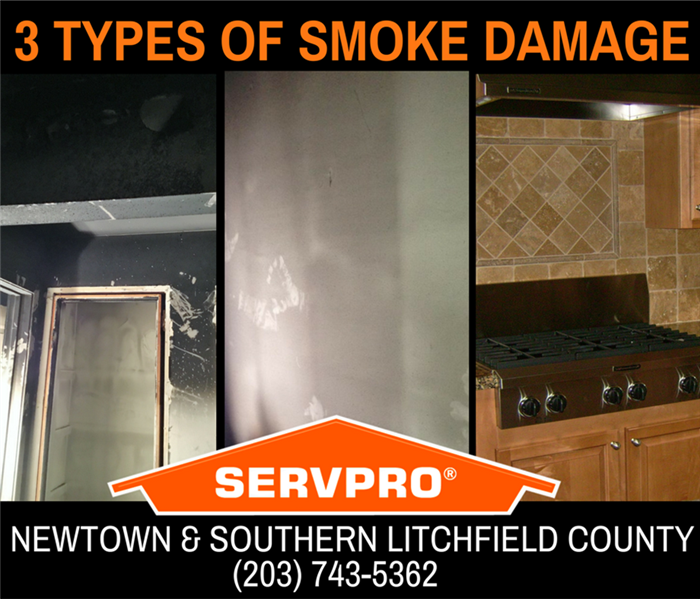 What type of smoke damage is on the walls of your CT home? This will help the SERVPRO team determine a clean up plan.
What type of smoke damage is on the walls of your CT home? This will help the SERVPRO team determine a clean up plan.
When we receive a call from a homeowner who has had a fire, one of the first questions we ask is "What is the cause of the fire?"
This information will help us determine what kind of smoke damage you have and establish the proper restoration plan. Not all smoke is equal and each different type requires a different method of cleaning. A quick breakdown of the types of smoke residue is:
- Wet Smoke Residue -Wet smoke residue occurs from smoldering fires with low heat. During these fires, synthetic materials such as plastics and rubbers, carpeting, furniture and electronics will have slowly smoldered. They tend to have a pungent odor and leave a sticky residue. During cleaning, wet smoke residue can smear, making cleanup more difficult.
- Dry Smoke Residue – Dry smoke residue occurs during fast burning fires that burn at a high temperature. Natural materials such as paper, leather, natural rubber and wood are present in dry smoke fires. Dry smoke residue is generally dry, powdery, gray in color and does not smear much. Homes that have experienced these fires are easier for our crew to restore.
- Protein Residue – Protein fires are most commonly caused when food burns in a kitchen. Protein residue is essentially invisible and a homeowner may be under a false impression that the damage is minor. However, there is actually soot covering the surfaces. If not properly removed, protein smoke will discolor paints, varnishes, and other finishes on your walls and cabinetry. One major indicator that there is an invisible residue after a kitchen fire is a very strong, obnoxious odor.
The SERVPRO of Newtown & Southern Litchfield County team treats each fire damage job individually and will determine which course of action to take after arriving at your home. Call us at (203) 743-5362 for a quick response, an evaluation of your home's fire damage and a professional restoration plan.
Choosing the right Christmas tree can reduce your risk of a house fire
12/18/2017 (Permalink)
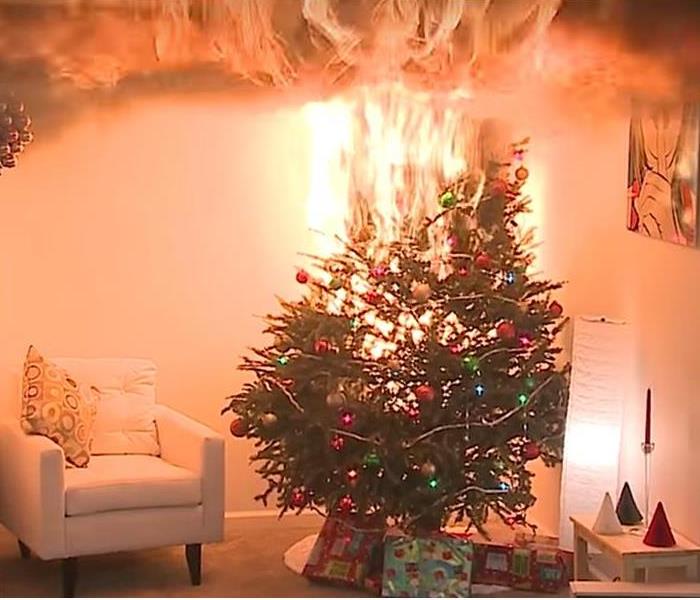 Failing to take safety precautions can cause your Christmas tree to catch fire
Failing to take safety precautions can cause your Christmas tree to catch fire
For many families in Litchfield County, the start of the Christmas season is marked by picking out a live Christmas tree from one of the area’s wonderful tree farms. For some, the annual ritual of the family venturing out into the cold together to find that perfect tree for their home, cutting it themselves and tying it to the roof of the car cannot be replicated with an artificial tree.
We appreciate a live tree ourselves however have also seen in over twenty years in the fire and damage business the devastation caused by a tree that has caught fire. When showcasing a live tree in your home, the combination of tree dryness, electrical malfunction with lights and poorly located heating sources can make for a deadly combination. If your holiday is not complete without a live tree, follow these safety precautions this month.
1. Choose your tree carefully: Fresh trees are less likely to catch fire, so look for a tree with vibrant green needles that are hard to pluck and don’t break easily from its branches. The best trees that retain moisture the longest are Fraser fir, Noble fir and Douglas fir. Eastern red cedar and Atlantic white cedar rapidly lose moisture and should be used only for a week or two.
2. Location, location, location: Always place your tree away from heat sources like fireplaces, radiators, candles, heat vents or lights, and keep the tree base filled with water to avoid a dry out.
3. Check your lights: Check old lights for any fraying of the wires. Do not overload light strands or electrical outlets. Also keep in mind that miniature and LED lights produce less heat than larger ones and will reduce the drying effect on trees.
4. Keep it watered: Choose a tree stand that holds at least a gallon of water and be sure to keep it full at all times.
5. Unplug your lights every night and when you leave the home. This will reduce the drying effect of lights and reduce the risk of the tree igniting unnoticed.
6. Take down the tree before it dries completely. A tree that is totally dry has needles turned a greenish gray and all needles and twigs break with a crack or crunch when crushed. In some tree species, you will see a needle drop but always do the crush test to be certain.
Have a kitchen fire action plan when you are cooking this month!
12/5/2017 (Permalink)
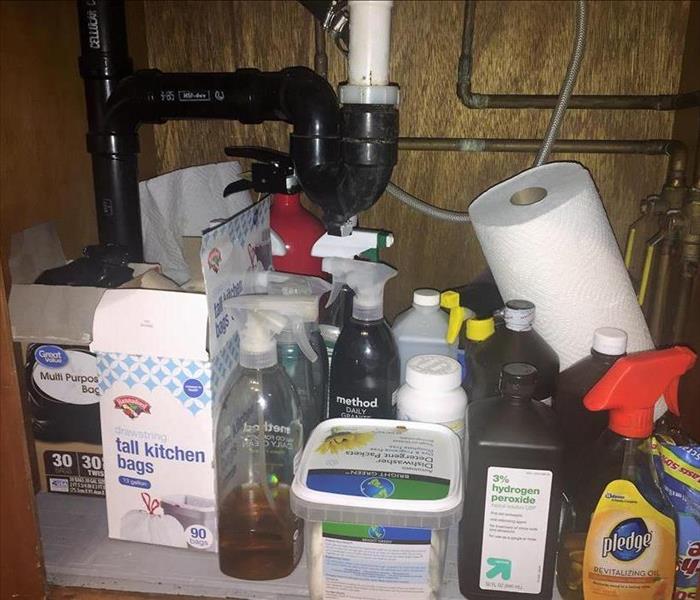 Can you easily find the fire extinguisher under this sink? Seconds count when you have a kitchen fire so keep your extinguisher in a handy place!
Can you easily find the fire extinguisher under this sink? Seconds count when you have a kitchen fire so keep your extinguisher in a handy place!
Fires that are started from cooking equipment are the number one cause of home fires in the United States. Cooking fires are the most common cause of injury from fire as well. According to a recent study by the National Fire Protection Association, 47% of home fires were caused by cooking.
It's December and with holiday baking and entertaining guests, most of us will be using our kitchens more often than usual. It only takes a moment of forgetfulness for a fire to start in your kitchen and your holidays interrupted. We've discussed ways to avoid kitchen fires in the past. It is also important to know how to extinguish the different types of fire.
Grease fires are the most common type of kitchen fire. Never attempt to extinguish a grease fire with water, as that can cause the fire to spread. The easiest way to smother a small grease fire is to cut off its oxygen source by covering the pot with a lid. If the fire is too large to safely do this, a Class B fire extinguisher should be used if available. If you don’t have a fire extinguisher, baking soda can be used in a pinch.
Don't let your Christmas cookies catch fire – keep your oven clean to avoid a grease fire inside and set a timer when baking. If you do have an oven fire, it should be extinguished with a fire extinguisher.
If you have an electrical fire from your toaster or another appliance, unplug it if you can safely do so and smother the fire or use a fire extinguisher.
The common thread to all of the advice in this article is that you should act quickly, avoid the use of water and know where your fire extinguisher is and how to use it! This alone can keep the damage a stove top fire causes contained, rather than your entire home being affected.
Even if you are successful in quickly extinguishing a kitchen fire, there might be soot and smoke that requires professional removal. Call SERVPRO of Newtown & Southern Litchfield at (203) 743-5362 to come out and quickly make your kitchen "Like it never even happened".
National Fire Prevention Month: Smoke detectors for the hard of hearing
10/23/2017 (Permalink)
Smoke Detectors for the Hard of Hearing
Most Connecticut homes have several smoke detectors installed. The public safety campaigns and state regulations requiring smoke detectors in homes have been successful.
People who are deaf or hard of hearing, however, may not be able to depend on the traditional smoke alarm to alert them to a fire. The elderly who may have diminishing hearing and live alone are at particularly at risk. If you have a difficult time hearing or have a loved one who does, there are a few options available that can help keep them safe.
- A strobe light alarm flashes when the home's smoke alarm sounds, warning those who may not hear the alarm of smoke.
- When people who are deaf are asleep, a pillow or bed shaker can wake them so they can escape. The shaker is activated by the sound of a smoke alarm.
SERVPRO of Newtown & Southern Litchfield County is here to help if you have a fire in your Bethel, CT area home. Call us at (203) 743-5362.
#smokedetectors #firesafety #nationalfirepreventionmonth #SERVPRO #likeitneverevenhappened
It's Fire Prevention Week- we discuss the cow that may have started it all.
10/9/2017 (Permalink)
Did you know that Fire Prevention Week is on record as the longest running public health observance?
It has been in existence since President Calvin Coolidge proclaimed the first National Fire Prevention Week on October 4-10, 1925. It is observed on the Sunday through Saturday period in which October 9 falls, in commemoration of the Great Chicago Fire, which began October 8,1871, and did most of its damage October 9.
The tragedy killed more than 250 people, left 100,000 homeless, destroyed more than 17,400 structures and burned more than 2,000 acres.
According to popular legend, the fire broke out after a cow - belonging to Mrs. Catherine O'Leary - kicked over a lamp, setting the barn on fire. But is this true?
According to the National Fire Prevention Association:
"Like any good story, the 'case of the cow' has some truth to it. The great fire almost certainly started near the barn where Mrs. O'Leary kept her five milking cows. But there is no proof that O'Leary was in the barn when the fire broke out - or that a jumpy cow sparked the blaze. Mrs. O'Leary herself swore that she'd been in bed early that night, and that the cows were also tucked in for the evening.
After the Great Fire, Chicago Tribune reporter Michael Ahern published a report that the fire had started when a cow kicked over a lantern while it was being milked. The woman was not named, but Catherine O'Leary was identified. Illustrations and caricatures soon appeared depicting Mrs. O'Leary with the cow.
In 1893, however, Ahern admitted he had made the story up.
"Mrs. O'Leary's cow" has attracted the attention and imagination of generations as the cause of the fire. Numerous references, in a variety of media, have been made in American popular culture, including films, television, and popular music.
But if a cow wasn't to blame for the huge fire, what was? Over the years, journalists and historians have offered plenty of theories. Some blamed the blaze on a couple of neighborhood boys who were near the barn sneaking cigarettes. Others believed that a neighbor of the O'Leary's may have started the fire. Some people have speculated that a fiery meteorite may have fallen to earth on October 8, starting several fires that day - in Michigan and Wisconsin, as well as in Chicago."
What we do know is that the fire changed the way firefighters thought of fire safety and how to educate the public and that countless lives have been saved and damage avoided to these efforts over the last nine decades.
Fire Prevention Week - Kitchen Fire Prevention in Fairfield County, CT
10/9/2017 (Permalink)
Our Fire Prevention Month tip today is:
Cook With Caution!
Cooking fires are the number one cause of home fires and home injuries. It only takes a brief moment for a kitchen fire to start and quickly grow out of control.
- Be on alert! Don't use the stove or stove top if you are sleepy or have consumed alcohol.
- Stay in the kitchen while you are frying, grilling, or broiling food.We have all walked away for a moment while cooking only to remember we were cooking by the smell of something burning. If you leave the kitchen for even a short period of time, turn off the stove.
- Use a timer to remind you of items that are cooking. If you have something cooking, check it regularly
- Keep flammables at a safe distance. Keep anything that can catch fire — potholders, wooden utensils, food packaging, towels or curtains — away from your stove top.
- If you have a small grease fire, smother the flames by sliding a lid over the pan and turning off the burner. Leave the pan covered until it is completely cooled.
- If the fire cannot be contained easily, just get out! When you leave, close the door behind you to help contain the fire.
- Call 9-1-1 from outside the home
After fire emergency services have made your home safe, call SERVPRO of Newtown and Southern Litchfield County at(203) 743-5362 for fire and water damage restoration.
Get ahead of winter in Brookfield with these house fire safety tips
9/27/2017 (Permalink)
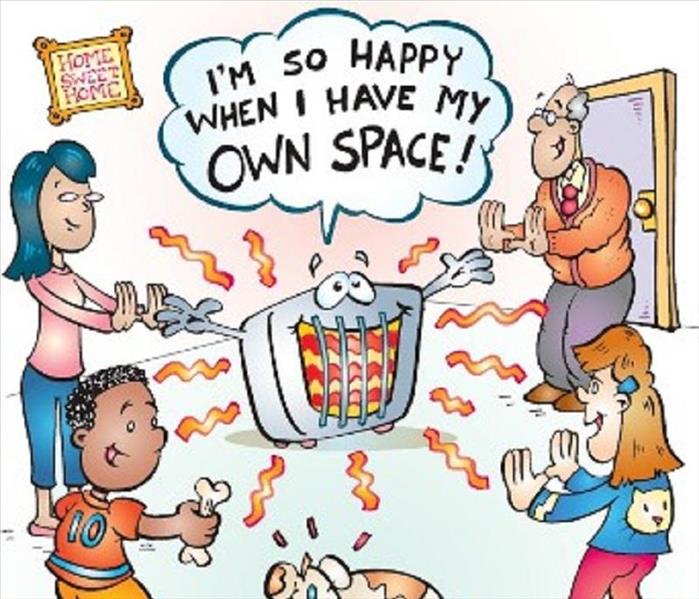 Be sure to keep space heaters at least 3 feet away from anything flammable to avoid a fire in your Southbury home.
Be sure to keep space heaters at least 3 feet away from anything flammable to avoid a fire in your Southbury home.
The wintertime brings unique challenges to homeowners in Fairfield County. SERVPRO of Newtown and Southern Litchfield County responds to calls in which homes have been damaged by chimney fires, oil burner puff backs, biohazardous oil spills and space heater fires as well as water damage from rescue efforts. Help your family keep it safe from a house fire while keeping warm this winter by following these recommendations this fall.
- Have your furnace inspected and serviced. This should be done by a qualified technician annually.
- Have your chimney and vents cleaned and inspected by a professional. They will check for creosote buildup as well as cracks in the lining. This is the easiest way to avoid chimney fires from creosote.
- Use dry, seasoned wood in your fireplace or wood stove to avoid creosote build up.
- Be sure that your fireplace screen is metal or heat-tempered glass, in good condition and secure in its position in front of the fireplace.
- Have a covered metal container ready to use to dispose cooled ashes. (The ash container should be kept at least 10 feet from the home and any nearby buildings.)
- Instruct your children to stay at least 3 feet away from the fireplace, wood/pellet stove, oil stove or other space heaters. Place safety gates around heat sources if young children are in the home.
- Make certain that portable space heaters have an automatic shut-off. They should also be plugged directly into an outlet (not an extension cord) and placed at least three feet from anything that can burn such as bedding, curtains and walls.
- Test your smoke alarms and make sure they are working. Your home should have smoke alarms on every level of the home, inside each sleeping room and outside each separate sleeping area.
- Test your carbon monoxide alarms and made sure they are working.
The fall is the perfect time to get ready for winter. Make sure that your Washington, CT home is ready and safe from fire and smoke damage. If you have a home fire this winter, call SERVPRO of Newtown and Southern Litchfield County at (203) 743-5362 for a quick response and home restoration built on over 30 years of training and experience.
Safely enjoy a camp fire in Litchfield County with these tips
7/14/2017 (Permalink)
One thing that we look forward to every summer is having a campfire in our backyard. There's something about the smell and sound of a fire that brings us close to nature. Add in some marshmallows and everybody is happy! Unfortunately, campfire accidents are common, resulting in thousands of ER visits a year.
Follow our safety tips to reduce your risk of injury.
Step 1: Check out the surroundings
Carefully choose your location avoiding any low hanging branches or near brush or bushes. These can easily go up in flames if the fire gets bigger than anticipated. You should also keep an 8 to 10 foot radius clear of anything such as brush, garbage as well as tents and chairs.
Step 2: Prepare your campfire ring
If an exisiting ring is not present, create one out of rocks. Make sure that the area surrounding the ring does not have any tripping hazards such as holes, roots or tree stumps. A child walking to get their next marshmallow can easily trip and get burned.
Step 3: Have water, a shovel and dirt at hand
It only takes a single gust of wind to cause your fire to grow out of control. In that case, you want to always have water, dirt or a shovel nearby to help reduce the flames or put it out completely if necessary.
Step 4: Never leave the fire unattended
Sometimes we get so comfortable with the fire that we walk away for "just a moment". Regardless of what is going on, make sure someone always has an eye on the fire. Especially keep an eye on pets and children that may be sitting or walking close by.
Step 5: Put it out right
Never leave a fire burning when you are going inside. Even hot embers can reignite and become a fire with a gust of wind. Smother the fire with dirt and make sure it is fully extinguished by stirring the embers around afterwards.
Enjoy your summer and be safe if you have a backyard fire in Connecticut this summer!
If you have fire damage at your Brookfield area home, call SERVPRO of Newtown & Southern Litchfield County at (203) 743-5362.
Don't ruin your 4th of July Barbecue, Litchfield County!
7/2/2017 (Permalink)
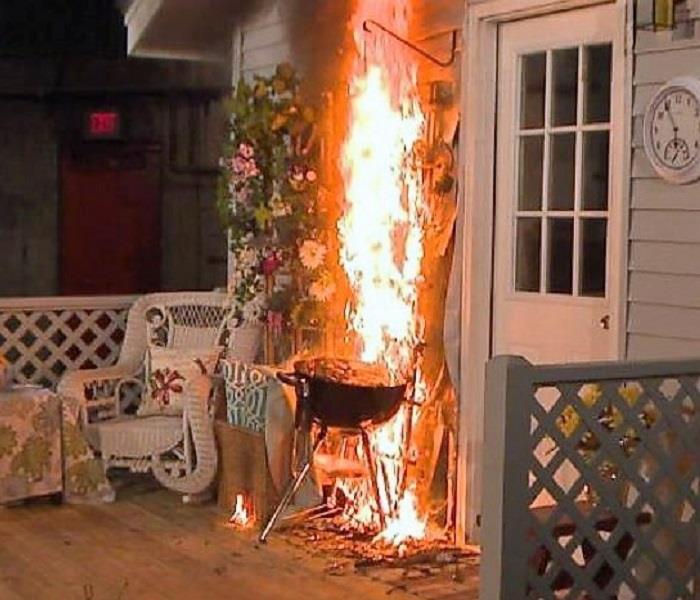 How many of our barbecue safety tips been broken in this image?
How many of our barbecue safety tips been broken in this image?
Friends, it is officially summertime and that means grilling season has hit Fairfield County! Before you grill, however, take caution. Over 7,000 Americans get injured on the grill each year, the majority of which are caused by user error. Follow these tips to keep your gathering fun and incident free.
- Keep your grill AT LEAST 10 feet away from your house. This includes areas with overhangs such as porches. A 'certain somebody' in our office learned the hard way that vinyl siding near a barbecue melts quite easily. Save your siding and move that grill far away!
- Clean your grill each time. Open up that fancy grill cleaning set that you received at last year's 'white elephant' and have some fun! Scrub that grill clean each time that it is used and remove the grease that can be a major cause of flare ups.
- Check for gas leaks. Here's a cool trick on how to check.Make a solution of half liquid dish soap and half water and rubbing it on the hoses and connections. Then, turn the gas on (with the grill lid open.) If the soap forms large bubbles, that's a sign that the hoses have tiny holes or that the connections are not tight enough.
- Keep the area clear. Keep your patio furniture, pillows, party lights and hanging baskets away from your grill, as they are highly combustible.
- Keep a spray bottle of water handy.That way, if you have a minor flare-up you can spray it with the water to instantly calm it. And, as a bonus, you can still eat your burger even after you've sprayed the flames out!
- Keep a fire extinguisher within a couple steps of your grill. Quickly extinguishing the fire will save your home and safety. Here's the catch, though - make sure that you know how to use it!
- Don't turn on the gas unless your grill lid is open! Keeping the lid closed causes gas to build up inside your grill, and when you do light it and open it, a fireball can explode in your face. And a fireball in the face almost always ruins the barbecue.
- Don't leave a grill unattended. Grilling is serious business. Fires double in size every minute. You cannot just put the steaks on the grill and walk away to watch the game. Man your post at all times and keep an eye on that grill!
- Don't overload your grill with fatty meats. If too much fat drips on the flames at once, it can cause a large flare-up that could light nearby things on fire.
- Don't use a grill indoors.I'm sure this goes without saying. Even a small little propane grill inside can cause a big fire as well as produce enough carbon monoxide to threaten the health of your family and kids. Keep grills outdoors where they can vent in the fresh air.
Keep it safe! Although it may make a good story someday, having a visit from the Fire Department is never a fun way to end you holiday!
Taking inventory of damaged belongings after New Milford area house fires
6/11/2017 (Permalink)
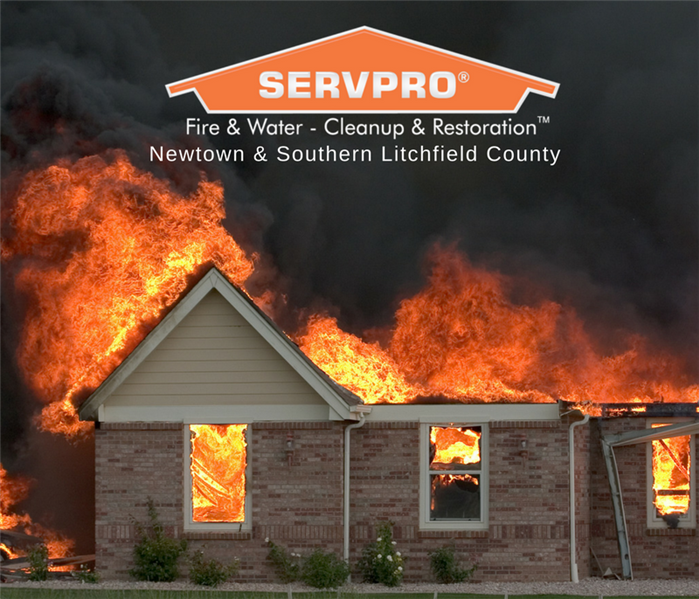 SERVPRO of Newtown & Southern Litchfield County goes through Fairfield County homes room by room to take inventory after house fires.
SERVPRO of Newtown & Southern Litchfield County goes through Fairfield County homes room by room to take inventory after house fires.
A house fire is a very traumatic and emotional experience for homeowner's. Not only has the structure of your Sandy Hook home been damaged, but the fire, smoke and soot also affects your belongings. At SERVPRO of Newtown and Southern Litchfield County we understand that your clothing, photographs, furniture and other belongings hold special meaning and memories.
When we are called to home after a fire loss, we use a system called the Contents Claim Inventory Service (CCIS). With CCIS, we go through the home room by room and create a detailed accounting of all of your belongings. With this list, we are able to assist homeowners when making a claim for damaged belongings with their home insurance company and help our customers settle insurance claims quicker.
Many items can be saved and restored after a fire however some are not salvageable. SERVPRO of Newtown and Southern Litchfield County assists homeowners in creating an inventory of damaged items, helping the recovery process go a little bit easier in a challenging time.
#housefire #firerestoration #litchfieldcounty #fairfieldcounty
How to use a fire extinguisher to protect your Sherman, CT home from damage
4/21/2017 (Permalink)
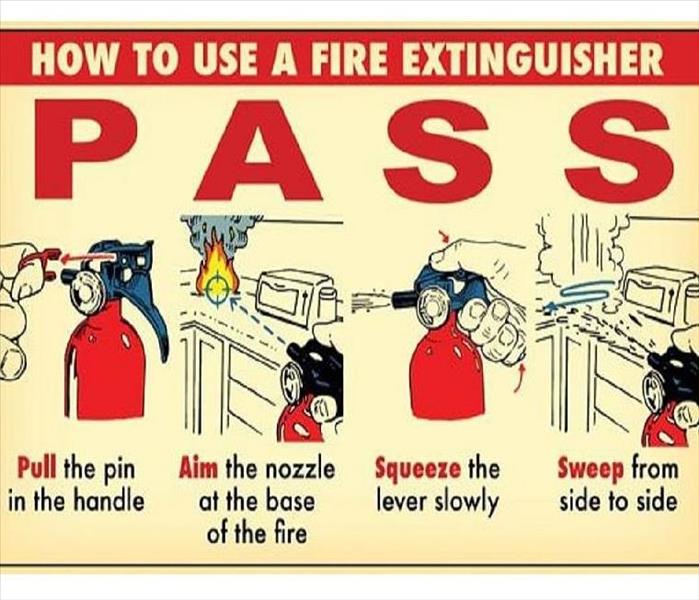 According to the U.S. Fire Administration, the best way to remember how to use a fire extinguisher is by remembering the acronym "PASS".
According to the U.S. Fire Administration, the best way to remember how to use a fire extinguisher is by remembering the acronym "PASS".
Most of us have at least one fire extinguisher in our Connecticut homes as well as in our schools and workplace. According to FEMA, the majority of Americans don’t know how to use an extinguisher. This is a dangerous statistic given that fires can double in size every 60 seconds. You don’t want to be frantically reading a manual while the a stovetop fire spreads throughout your kitchen. While operating one is not difficult, there are a few key rules that you should know.
Fire extinguishers are categorized by a variety of classes based on the type of fire they are formulated to extinguish. Most fire extinguishers for homes and public spaces are classified as Class ABC extinguishers, meaning they’re suitable for putting out wood and paper fires, flammable liquid fires, and electrical fires. If you work in a commercial kitchen, your extinguisher is most likely a Class K.
Class A – Ordinary solid combustibles like wood, cloth, and paper products.
Class B – Flammable liquids and gases.
Class C – Electrical fires. (Do not use water to put out this kind of fire – you could get electrocuted!)
Class D – Flammable metals.
Class K – Oils and grease fires. (Never use water on a grease fire – it will cause the flames to explode and spread.)
If you have a fire in your home, a good rule of thumb in determining whether a fire extinguisher will be effective on it is the height of the fire. If the fire is taller than you, your extinguisher most likely will not be able to extinguish the fire and it is recommended that you vacate the premises and dial 9-1-1.
If you are taller than the fire, position yourself in a location where you can make an exit if necessary and confirm that you have the right type of extinguisher for your fire.
According to the U.S. Fire Administration, the best way to remember how to use a fire extinguisher is by remembering the acronym "PASS".
Pull the pin.
Aim the nozzle at the base of the fire. Hitting the tops of the flame with the extinguisher won’t be effective.
Squeeze the trigger. In a controlled manner, squeeze the trigger to release the agent.
Sweep from side to side. Sweep the nozzle from side to side until the fire is put out. Keep aiming at the base while you do so. Most extinguishers will give you about 10-20 seconds of discharge time.
Slowly back away. Even if the fire appears to be extinguished, don’t turn your back on it. There might be unseen hot spots or hidden fires that can ignite into a large flame at any moment.
Once you’ve used a fire extinguisher, even if you didn’t deplete all the pressure, you must get it recharged.
If your Washington, CT home has a fire, SERVPRO of Newtown and Southern Litchfield County has the experience to clean up fire extinguisher residue as well as water and fire damage. Call us at (203) 743-5362
Furnace puffback's and their sticky aftermath in Fairfield County
3/7/2017 (Permalink)
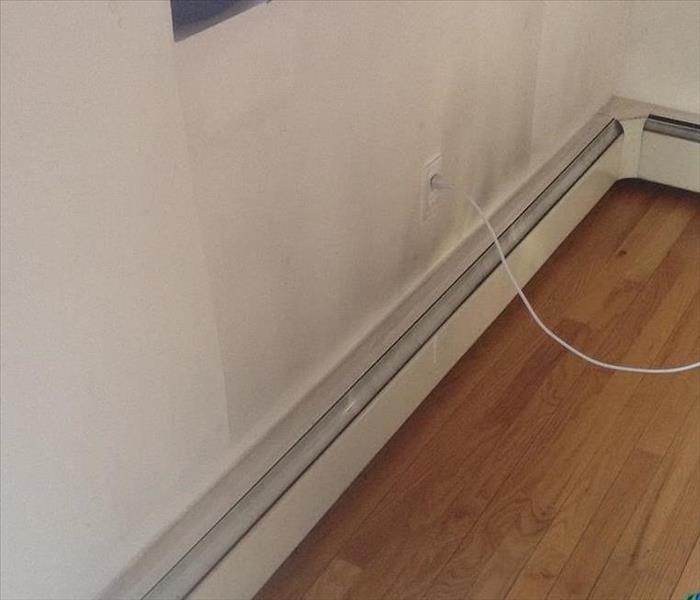 Soot on a wall after a furnace puffback in Bethel, CT
Soot on a wall after a furnace puffback in Bethel, CT
Many people have never heard of a furnace puffback until they experience one themselves. A puffback is an explosion inside the burner chamber of the furnace or boiler. Puff backs can occur due to an oil burner malfunction in which the burner doesn't ignite immediately and oil fumes are allowed to build up before ignition, causing an explosion when the furnace turns on. Puff backs can also be caused by a partially clogged or cracked nozzles, improper nozzle angle, cracked electrodes, poor adjustment of the air-fuel mixture, a defective spark transformer, shorted ignition cables or dirty or low-grade fuel. Regular maintenance can help Litchfield County homeowners reduce the risk of a furnace puffback.
The aftermath of a puffback is the soot and streaks that the explosion blew throughout your home. Often every surface – including carpeting, furniture, walls and drapery - is covered with this black, sticky substance that includes a mixture of oil that is very difficult to remove from any surface. Cleaning up after a puffback is not a do it yourself job- it requires professional cleaning to remove the soot that is spread throughout your home. Do not attempt to clean the soot itself – household cleaners are not effective against soot and may make the problem worse. For example, attempts to wash soot off of a flat-painted wall or ceiling usually leave greasy smears. At SERVPRO, we use proprietary tools and cleaners that absorb the soot without spreading it. Luckily, puffback's are usually covered under your homeowner's insurance.
If you experience a furnace puffback, call your SERVPRO of Newtown and Southern Litchfield County office at (203) 743-5362. Our smoke and fire damage specialists have the equipment and training to quickly return your home to a safe, clean, and comfortable environment for you and your family. We're faster to any disaster and are dedicated to responding immediately so that you can recover quickly, with less disruption to your life.
After the fire is out-smoke and soot removal in Litchfield County
2/24/2017 (Permalink)
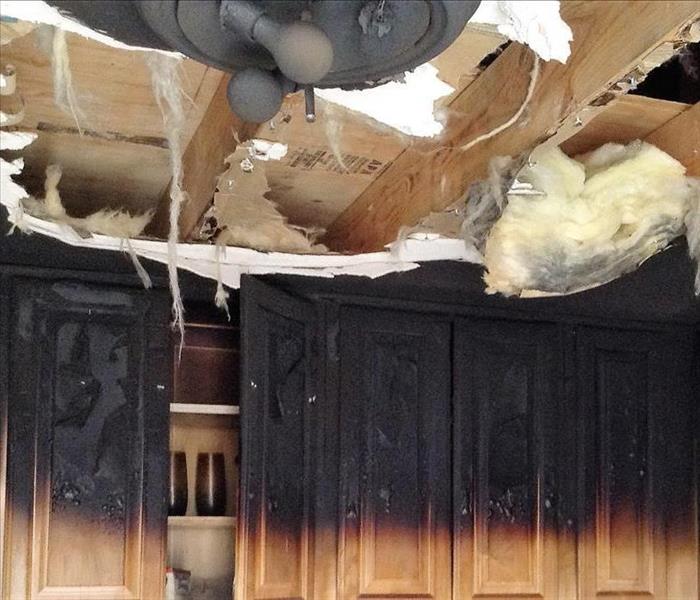 Kitchen Fires can cause smoke and soot throughout the house
Kitchen Fires can cause smoke and soot throughout the house
Not only can the flames of a fire cause enormous damage, the ash, soot and smoke residue that remains will make the home almost noxious to live in. Both can create irritating odors, discolor walls or ceilings and cause breathing issues if there is a high concentration of ash left over.
Even a small home fire can cause a great amount of damage due to soot and smoke damage. We have arrived at jobs where a small kitchen fire may have caused minimal structural damage, yet smoke has managed to permeate items throughout the home and soot has covered every surface of the home. In the pictures, the home doesn't show much damage, yet the clean up job is a big one.
When called to a job in the New Milford, Ct area, SERVPRO of Newtown and Southern Litchfield County crew members have the expertise and equipment to properly treat all surfaces of ash and soot. Because ash can reactive negatively to certain cleaning agents, possibly causing permanent damage and toxic fumes, this is not a job that can be done with store bought cleaning agents. We have a large production facility in which we clean and store personal belongings off site while the home restoration is ongoing.
Smoke odors are extremely hard to remove and can’t be done with standard equipment. Fortunately, at SERVPRO of Newtown and Southern Litchfield County, we keep thermal foggers and other sophisticated odor removal equipment on hand to counter noxious smoke odors. We can reach into all parts of your Fairfield County home, including inside floors and walls.
SERPVRO of Newtown and Southern Litchfield County is IICRC Certified to restore your home after a fire. Call us at (203) 743-5362 if you need help bringing your Sandy Hook home back to pre-fire condition.
Choosing and Caring for a Christmas Tree in Connecticut
11/30/2016 (Permalink)
For many families in Litchfield County, the start of the Christmas season is marked by picking out a live Christmas tree from one of the area’s wonderful tree farms. For some, the annual ritual of the family venturing out into the cold together to find that perfect tree for their home, cutting it themselves and tying it to the roof of the car cannot be replicated with an artificial tree.
We appreciate a live tree ourselves however have also seen in over twenty years in the fire and damage business the devastation caused by a tree that has caught fire. When showcasing a live tree in your home, the combination of tree dryness, electrical malfunction with lights and poorly located heating sources can make for a deadly combination. If your holiday is not complete without a live tree, follow these safety precautions this month.
1. Choose your tree carefully: Fresh trees are less likely to catch fire, so look for a tree with vibrant green needles that are hard to pluck and don’t break easily from its branches. The best trees that retain moisture the longest are Fraser fir, Noble fir and Douglas fir. Eastern red cedar and Atlantic white cedar rapidly lose moisture and should be used only for a week or two.
2. Location, location, location: Always place your tree away from heat sources like fireplaces, radiators, candles, heat vents or lights, and keep the tree base filled with water to avoid a dry out.
3. Check your lights: Check old lights for any fraying of the wires. Do not overload light strands or electrical outlets. Also keep in mind that miniature and LED lights produce less heat than larger ones and will reduce the drying effect on trees.
4. Keep it watered: Choose a tree stand that holds at least a gallon of water and be sure to keep it full at all times.
5. Unplug your lights every night and when you leave the home. This will reduce the drying effect of lights and reduce the risk of the tree igniting unnoticed.
6. Take down the tree before it dries completely. A tree that is totally dry has needles turned a greenish gray and all needles and twigs break with a crack or crunch when crushed. In some tree species, you will see a needle drop but always do the crush test to be certain.
Tips to keep us out of your kitchen this Thanksgiving!
11/16/2016 (Permalink)
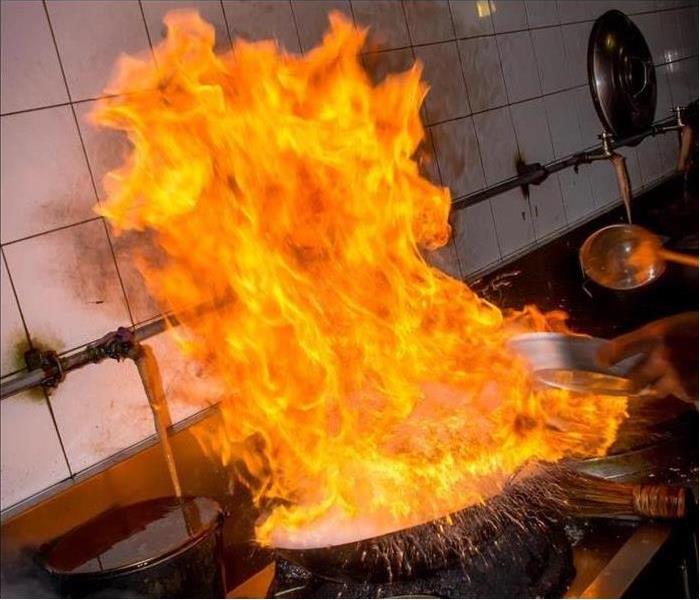 Never pour water on a grease fire!
Never pour water on a grease fire!
Thanksgiving is a day filled with family, parades, football and, of course, food! The kitchen is the heart of home, especially during the holidays when most of us in Litchfield County are preparing a meal with many more recipes, in larger quantities and with more cooks in the kitchen than usual!
Unfortunately, Thanksgiving Day also has the highest number of home fires annually. In 2013, Thanksgiving Day had 1,550 reported kitchen fires, which is 230% above the average number of fires per day. Keep these kitchen safety reminders in mind as you prepare your Thanksgiving feast!
"Be on time"
With so many things on your "to do" list, guests coming and going and multiple items cooking, be sure to set timers so that you don't remember to take something out of the oven too late! (nobody likes their stuffing THAT dry!)
“Stand by Your Pan”
Have a designated cook in the kitchen at all times so that food is not left unattended. This is the most common source of kitchen fires. It only takes a moment for a kitchen fire to start and with a vigilant cook in the kitchen, catching it immediately is the key to avoiding the fire spreading.
"If you fry, don't make it too high!"
The popularity of deep frying the turkey has soared (We at SERVPRO of Newtown and Southern Litchfield County haven't gone this route because we are traditionalists but we hear it's quite delicious!). An overfilled cooking pot will cause cooking oil to spill when the turkey is put in, and a partially frozen turkey will cause cooking oil to splatter when put in the pot. Even a small amount of cooking oil spilling on a hot burner can cause a large fire. Play it safe and fry your bird outside.
"For grease fires, water makes it go higher!"
Never attempt to extinguish a grease fire with water or a wet towel. Water will cause the flames to flare up and spread quickly. Turn off the stove and cover the fire with a lid if it is safe to do so, thereby removing the oxygen from reaching the fire. Use a fire extinguisher, which should be stored in a convenient kitchen location (not hidden under the kitchen sink!) If you do not have a fire extinguisher, baking soda is also effective at putting out grease fires however you do need to use quite a bit of it.
We wish all of you a Happy Thanksgiving!
It's National Fire Prevention Week
10/3/2016 (Permalink)
October 9-15 is Fire Prevention Week- a time to make sure that your home has fire safety measures in place. In 2015, there were 1,345,500 fires reported in the United States. Every 86 seconds, one home structure fire was reported and every day, 7 people lost their lives to residential fires. At SERVPRO of Newtown and Southern Litchfield County, we have seen firsthand the devastation a home fire can cause.
Many home fires are preventable with some forethought and care to minimize the risks. Among the common causes of home fires are leaving candles unattended, smoking and leaving unattended food cooking on the stove top. Make it a habit to double check that the flame is out and properly extinguished when smoking or using candles.
Electrical fires can start from overloaded outlets, equipment malfunction or overheated appliances. Clothes washers and dryers account for over 16,000 home fires each year. We recommend that you check your dryer vent to make sure there aren't any blockages and clean your lint screen regularly.
While lightning fires are not preventable, personal injury from lightning can be. Unplug electrical appliances, avoid using plumbing fixtures and do not use corded devices during thunderstorms.
Tragically, Christmas trees are one of the main causes of home fires. Take care to always keep trees well watered, do not use faulty Christmas tree lights and always turn off your tree at night. Try to avoid using a live tree in a room with a wood stove or near heat sources that will dry them out.
Here in Connecticut, many of us use alternative heat sources such as wood burning stoves and portable heaters. Take care to be sure that wood stoves are used properly and that wood is stored away from the stove and furniture and other combustible items are at least 3 feet from the stove. Portable electric heaters should also be kept 3 feet from flammable items such as curtains and bedding. Additionally, do not leave a space heater on overnight or while sleeping.
Despite taking preventative measures, home fires will still occur. Be prepared with ways to minimize the damage and protect your family from injury. Smoke detectors should be on each floor of your home and in each bedroom. Test all smoke detectors regularly and replace detectors over 10 years old. Keep fire extinguishers on each floor of your home and make sure you know how to use it. Many newer homes are equipped with a fire sprinkler system. If you are building a home, having a system installed may be included in your mortgage. Having rope or fire ladders on the second floor of the home can help family members escape. Make a family escape plan and rehearse it with your family.
Taking these measures can help minimize the damage of a home fire and protect your loved ones. If you do experience a home fire in your New Milford home, please call us at (203) 743-5362. We specialize in fire damage restoration – from cleaning soot, removing smoke smells and residue from personal items and cleaning up the secondary water damage rescue efforts leave behind.
Litchfield County Smoke and Soot Restoration
5/31/2016 (Permalink)
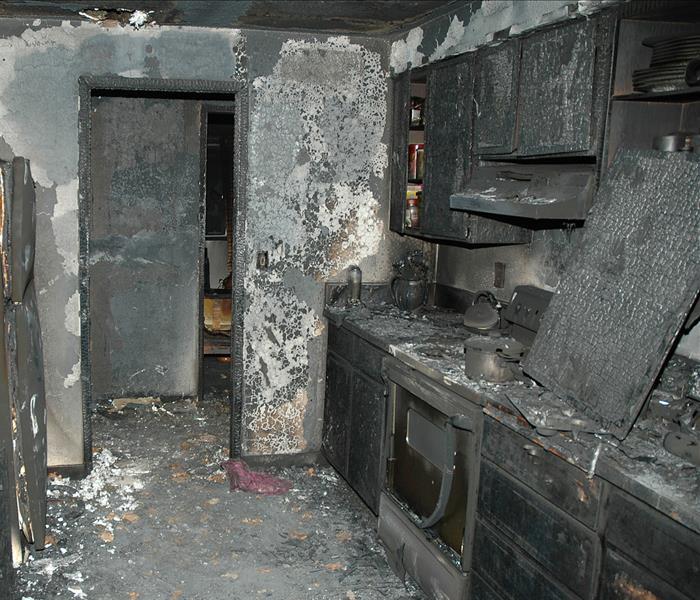 Smoke and Soot Damage Can Cause a Pervasive Odor in Your Litchfield County Home.
Smoke and Soot Damage Can Cause a Pervasive Odor in Your Litchfield County Home.
Smoke and soot is very invasive and can penetrate various cavities within your home, causing hidden damage and odor. Our smoke damage expertise and experience allows us to inspect and accurately assess the extent of the damage to develop a comprehensive plan of action.
Smoke and soot facts:
- Hot smoke migrates to cooler areas and upper levels of a structure.
- Smoke flows around plumbing systems, seeping through the holes used by pipes to go from floor to floor.
- The type of smoke may greatly affect the restoration process.
Different Types of Smoke
There are two different types of smoke–wet and dry. As a result, there are different types of soot residue after a fire. Before restoration begins, SERVPRO of Newtown and Southern Litchfield County will test the soot to determine which type of smoke damage occurred. The procedures will then be based on the information identified during pretesting. Here is some additional information:
Wet Smoke – Plastic and Rubber
- Low heat, smoldering, pungent odor, sticky, smeary. Smoke webs are more difficult to clean.
Dry Smoke – Paper and Wood
- Fast burning, high temperatures, heat rises therefore smoke rises.
Protein Fire Residue – Produced by evaporation of material rather than from a fire
- Virtually invisible, discolors paints and varnishes, extreme pungent odor.
Our Fire Damage Restoration Services
Since each smoke and fire damage situation is a little different, each one requires a unique solution tailored for the specific conditions. We have the equipment, expertise, and experience to restore your fire and smoke damage. We will also treat your family with empathy and respect and your property with care.
Have Questions about Fire, Smoke, or Soot Damage?
Call Us Today – (203) 743-5362





 24/7 Emergency Service
24/7 Emergency Service
